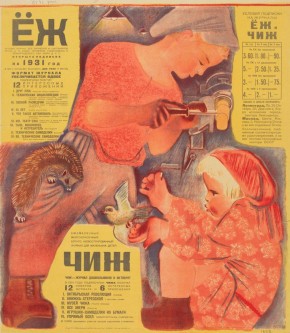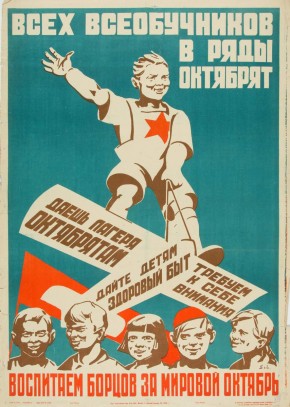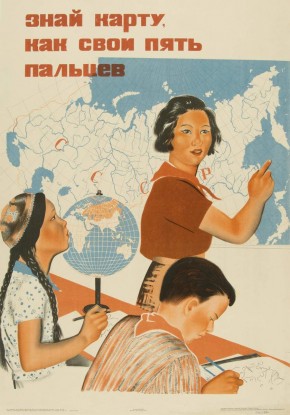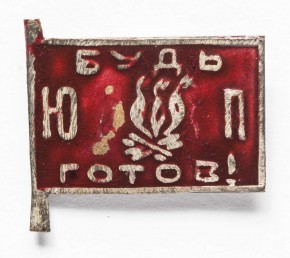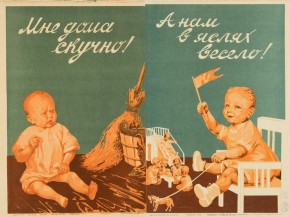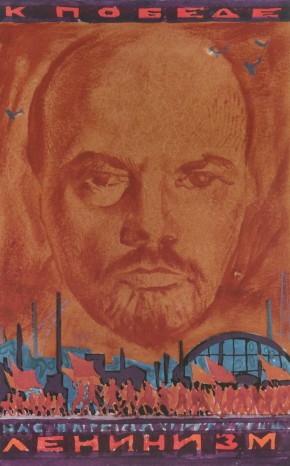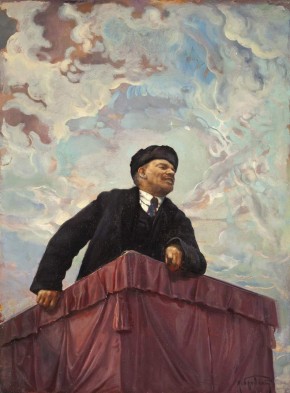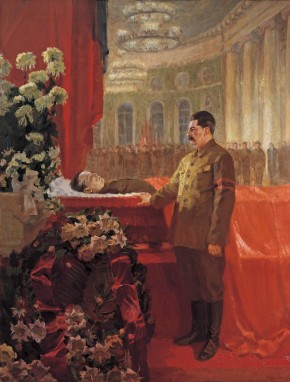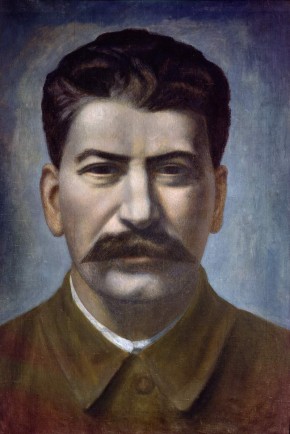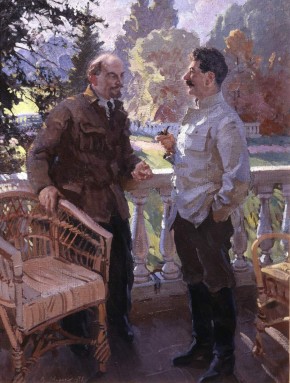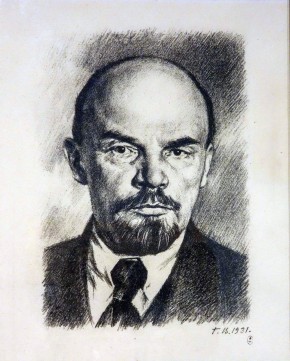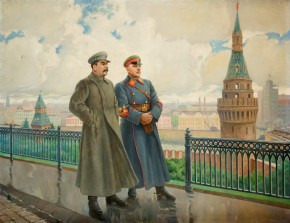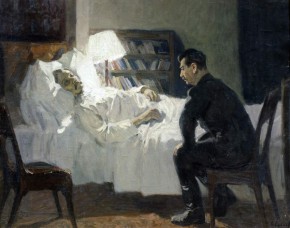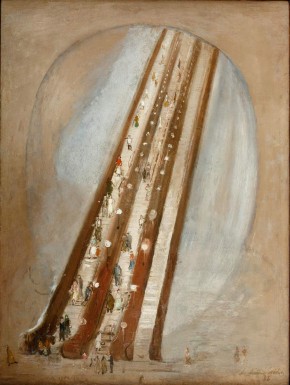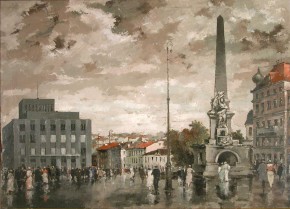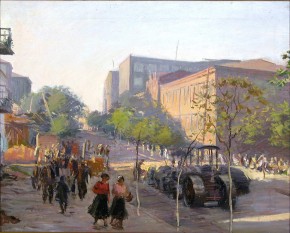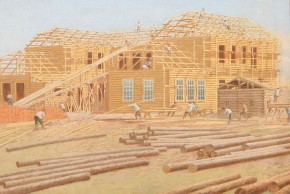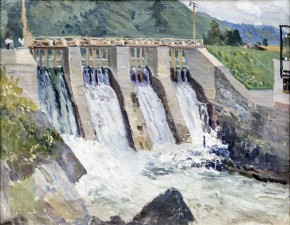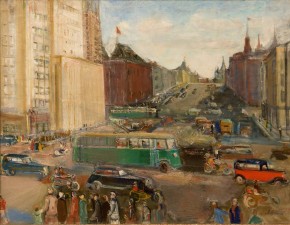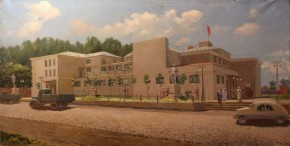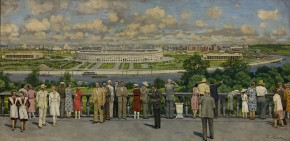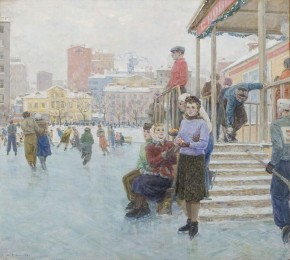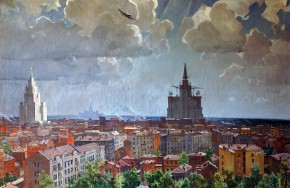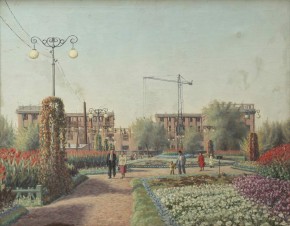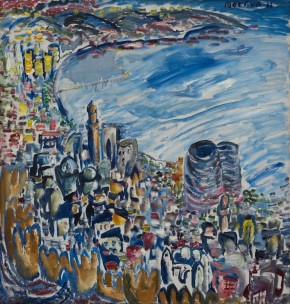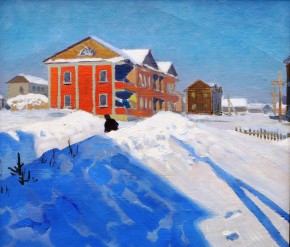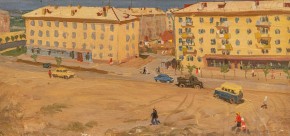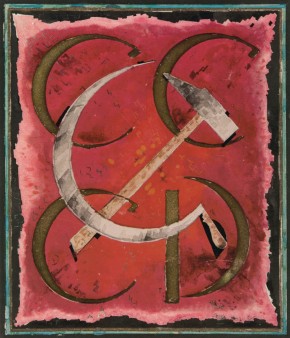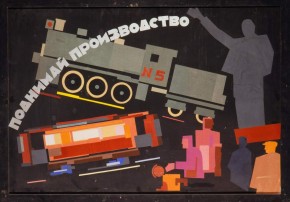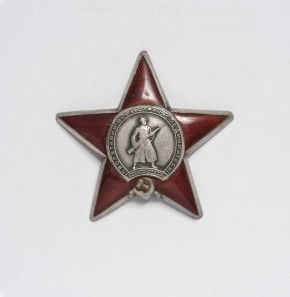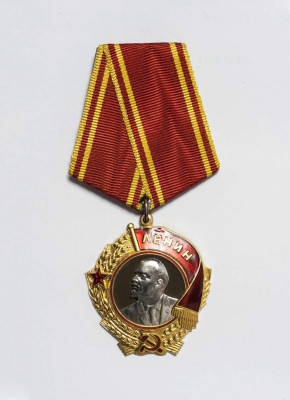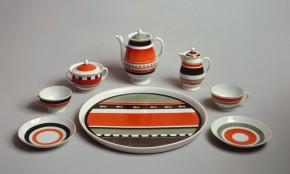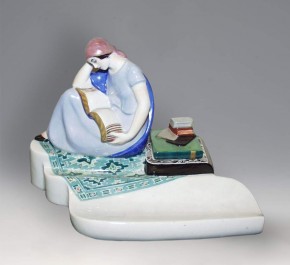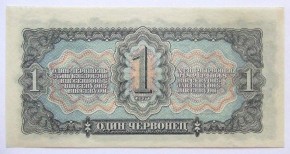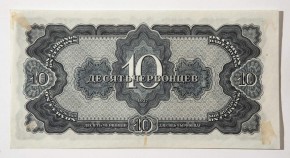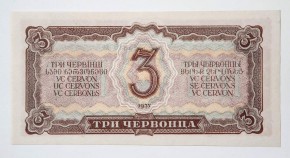Advanced search collections
Self-Portrait
- 1918
- Canvas, oil. 80,5 x 65
- The State Russian Museum
- Ж-2400
Фигура «Женщина, вышивающая красное знамя»
- Porcelain, overglaze decoration, gilding.
- The State Russian Museum
- СФ-136
Festivities in Honour of the Second Comintern Congress on 19 July 1920. Demonstration on Uritsky Square (now Palace Square)
- Canvas, oil.
- The State Russian Museum
- Ж-6148
The Comintern or the Communist International was the international organisation founded to advocate the world communist movement. The Second Congress of the Comintern started working in St. Petersburg on 19 July 1920. The delegated from 25 countries took part in the Congress. Isaac Brodsky engaged Boris Kustodiev, one of the greatest artists of the World of Art union, to produce a painting devoted to one of the important events of post-revolutionary time.
Using peculiar to him decorative manner and carefulness in depiction of people’s types the artist represented the atmosphere of the celebration of the representatives of different nations who had come to the Congress. Being disabled because of the illness the artist had to travel by car of the PetroSovet round the city exploring the signs of the new city life that were unusual for him, made sketches and immersed in the atmosphere of the celebration. All these observations resulted in a free composition in which red colour different in tones dominated. The different tones of red along with depiction of the crowd in general and individual figures expressed the idea of celebration. “You should have waited for such street”, - the artist recollected. He was sure that “the painting must be the document of our descendants”.
Kettle with lid
- Porcelain.
- The State Russian Museum
- Сф-1344 а,б
В Советской республике не должно быть больных и беспризорных детей! Здоровое физическое и духовно молодое поколение - верный проводник идей коммунизма!
- 1923
- Paper, chromolithograph. 61,0 х 102,0
- The State Russian Museum
- Гр.Пл.-1307
Все в общество рабочий патронат "Друг детей". На борьбу с беспризорностью
- 1923 (?)
- Paper, chromolithograph. 92,5 х 69,5
- The State Russian Museum
- Гр.Пл.-752
Пионерки двадцатых годов
- Canvas, oil.
- Нижнетагильский музей изобразительных искусств
- Ж-878
Портрет С. М. Буденного
- 1923
- Cardboard, oil. 42 х 27
- The State Russian Museum
- Ж-6475
Сервиз с супрематической росписью
- 1923
- Porcelain, overglaze decoration.
- The State Russian Museum
- СФ-13-18
Чашка (получашка) «Супрематизм»
- 1923
- Porcelain, overglaze decoration.
- The State Russian Museum
- СФ-27
Чернильница с крышкой «Супрематизм с „планитом“»
- 1923-1924
- Porcelain, overglaze decoration. 12,7 х 16 х 14,1
- The State Russian Museum
- СФ-29
Design for the Decoration of Uritsky Square in Petrograd on the First Anniversary of the October Revolution
- plywood, oil.
- The State Russian Museum
- ЖС-576
Nathan Altman was commissioned to design the festive decorations for Uritsky (Palace) Square. The artist set himself the task of altering the entire outward appearance of the square, contrasting the beauty of the victorious people to the beauty of Imperial Russia. According to the principle of contrast, the angular, uneasy and brightly painted planes of the building the artist covered in red constructions, which served as a background for all of Petrograd s holiday decorations.
Vladimir Lenin. At the Red Square
- 1924
- Paper, watercolour. 40 х 60,5
- The State Russian Museum
- РС-19706
Всем вам, бабы, надо знать, как ребенка воспитать!
- Paper, chromolithograph. 100,7 х 71,5
- The State Russian Museum
- Гр.Пл.-1305
Да здравствует комсомол! На смену старшим молодая рать идет
- 1924
- . 93,2 х 59,6
- The State Russian Museum
- Гр.Пл.-2327
Красный флот - защита СССР от врагов
- Paper, chromolithograph.
- The State Russian Museum
- Гр.Пл.-1171
Курорт
- 1924
- Canvas, gouache. 107 x 71
- The State Russian Museum
- ЖС-1836
Октябрина
- 1924
- Bronze. 30 x 19 x 17
- The State Russian Museum
- СО-1237
Орден Боевого Красного Знамени
- 1924
- Silver, enamel, .
- The State Russian Museum
- Мед.А-4434
Портрет В. И. Ленина
- 1924
- Canvas, oil. 97,1 х 80,3
- Музей изобразительных искусств Республики Карелия (Петрозаводск)
- ЖК-37
Petrov-Vodkin Kuzma Sergeyevich
1878, Khvalynsk (Saratov Province) - 1939, LeningradPainter, graphic artist, writer on art, history painter, portraitist. Studied at the Baron Stieglitz Central School of Technical Drawing (1895-97), under Abram Arkhipov and Valentin Serov at the Moscow School of Painting, Sculpture and Architecture (1897-1904), at Anton Aube\'\'s school in Munich (1901) and private academies in Paris. Contributed to exhibitions (from 1898). Contributed to the Salon d\'\'Automne (1906-07, 1908), Sergei Makovsky Salon (1909), Union of Russian Artists (1909, 1910), Golden Fleece (1909), Union of Youth (1910), World of Art (191124), Second Post-Impressionist Exhibition (1912), First Free Exhibition of Works of Art (1919), Association of Artists of Revolutionary Russia (1923, 1928), Four Arts (1925-29), World Exhibition in Brussels (1910) and the International Exhibitions in Rome (1911), Malmo (1914) and Venice (1924, 1928). Taught at the Elizaveta Zvantseva School of Painting and Drawing in St Petersburg (1910-15) and the Free Art Studios/Academy of Arts (1918-38). Honoured Artist of Russia (1930).
Danko Natalia
State Porcelain Factory
Kustodiev Boris Mikhailovich
1818, Astrakhan - 1927, LeningradPainter. Studied under Vasily Savinsky and Ilya Repin at the Higher School of Art, Imperial Academy of Arts (1896-1903). Fellow of the Imperial Academy of Arts in France and Spain (1903-1904). Academician of painting (1909). Founding member of the New Society of Artists (1904) and member of the Union of Russian Artists (1907), World of Art (1910) and the Association of Artists of Revolutionary Russia (1923). Contributed to exhibitions (from 1900). Contributed to the periodical exhibitions of the Moscow Society of Lovers of the Arts (1900-1901), Spring Exhibitions of the Imperial Academy of Arts (1900-1903) and the exhibitions of the New Society of Artists (1904-1908), Union of Russian Artists (1907-1910), World of Art (1910-1924), Association of Artists of Revolutionary Russia (1923, 1925) and the International Exhibitions in Munich (1901, gold medal; 1909) and Malmo (1914, gold medal). Designed for theatres in Moscow and St Petersburg (from 1911).
Avilov Mikhail
1882, St Petersburg — 1954, LeningradPainter. Studied at the School of Drawing, Society for the Encouragement of Arts (1893), worked as an icon-painter at the New Athos Monastery. Studied at Lev Dmitriyev-Kavkazsky’s studio (1903–1904), Higher School of Art, Imperial Academy of Arts (1904–1905, 1907–1913). Contributed to exhibitions (from 1908). Member of the Association of Artists of Revolutionary Russia (1923–1928), Union of Soviet Artists (from 1929), Union of Artists of the USSR (from 1932), exhibitor of the Arkhip Kuindzhi Society (1917–1930). Taught at the painting and drawing courses in Tyumen (1918–1921); Drawing School at the Society for the Encouragement
of Arts, Leningrad College of Art and Industry, (1922(21?)–1930); taught drawing and painting at the Armoured Vehicle Courses (from
1930), at the Ilya Repin Institute of Painting, Sculpture and Architecture (1947–1954). Professor (from 1948), doctor of art history (from 1948), full member of the Academy of Arts of the USSR (from 1947). People’s Artist of the RSFSR (from 1953). Stalin Prize (first degree) for works created in 1943–1944 (Duel on Kulikovo Field (Duel between Peresvet and Chelubei), 1943).
Malevich Kazimir Severinovich
1878, Kiev - 1935, LeningradPainter, graphic artist, writer on art, portraitist, landscapist, abstractionist. Studied at the Kiev School of Art (1895-1896) and Fyodor Roehrberg\'s studio in Moscow (1906-1910). Contributed to exhibitions (from 1905). Contributed to the exhibitions of the Moscow Fellowship of Artists (from 1907), Donkey\'s Tail (1912), Target (1913), Der Blaue Reiter (1912), Salon des Independants (1914), Tramcar V. First Futurist Exhibition (1915) and 0,10. Last Futurist Exhibition (1915-1916). Designed the sets and costumes for the Futurist opera "Victory Over the Sun" (1913). Member of the Union of Youth (1910) and Jack of Diamonds (1910, 1916). Founded the AFFIRMES OF THE NEW ARTgroup (1920). Worked for Department of An People\'s Commissariat of Education (1918-1919). Director of the Museum/Institute of Artistic Culture in Petrograd/Leningrad (1923-1926).
Unknown painter
Сварог Василий Семенович
Суетин Николай Михайлович
Чашник Илья Григорьевич
Chernyshev Nikolai
Altman Nathan Isaevich
1889, Vinnitsa - 1970, LeningradPainter, graphic artist, sculptor, book, theatrical and cinema designer. Studied under Kiriak Kostandi and Gennady Ladyzhensky at the Odessa School of Art (1903-07) and at the Maria Vasilyeva Free Russian Academy in Paris (1910-11). Contributed to exhibitions (from 1906). Contributed to the exhibitions of the Fellowship of South Russian Artists (1910), Union of Youth (1913-14), World of Art (1913, 1915, 1916) and the Jewish Society for the Encouragement of Artists (1915-19; founding member). Taught at Mikhail Bernstein\'s studio (1915-16) and the State Free Art Studios in Petrograd (1918-20). Member of Department of An, People\'s Commissariat of Education (1918-21). Research assistant of the Institute of Artistic Culture (1923). Designed for theatres. Honoured Artist of the Russian Soviet Federater Socialist Republic (1968).
Андриянов Александр Яковлевич
Brodsky Isaac izraelevich
1883 (1884), Sofievka Tauride province. - 1939, LeningradPainter, graphic artist; teacher. Studied at the Odessa School of Art (1896–1902) and the Higher School of Art, Imperial Academy of Arts (1902–1908). Fellow of the Imperial Academy of Arts in France and Italy (1909–1911). Contributed to exhibitions (from 1904), including the International Exhibitions in Rome (1911), Munich (1913, gold medal) and others. Taught at the Ilya Repin Institute of Painting, Sculpture and Architecture (from 1932–1939, professor), director of the All-Russian Academy of Arts (from 1934). Honoured Artist of Russia (1934).
Векслер Михаил (Монаш) Соломонович (Шлемович)
Изенберг Владимир Константинович
Комаров Алексей Иванович
Samokhvalov Alexander Nikolaevich
1894, Bezhetsk (Tver Province) - 1971, LeningradPainter, graphic artist, theatrical designer, applied artist, sculptor.
Studied architecture at the Higher School of Art, Imperial Academy of Arts (1914-18) and at the Free Art Studios/Higher Art and Tech¬nical Studios in Petrograd (1920-23). Contributed to exhibitions (from 1917).
Self-Portrait
- 1918
- Canvas, oil. 80,5 x 65
- The State Russian Museum
- Ж-2400
Фигура «Женщина, вышивающая красное знамя»
- Porcelain, overglaze decoration, gilding.
- The State Russian Museum
- СФ-136
Пионерки двадцатых годов
- Canvas, oil.
- Нижнетагильский музей изобразительных искусств
- Ж-878
Портрет С. М. Буденного
- 1923
- Cardboard, oil. 42 х 27
- The State Russian Museum
- Ж-6475
Портрет В. И. Ленина
- 1924
- Canvas, oil. 97,1 х 80,3
- Музей изобразительных искусств Республики Карелия (Петрозаводск)
- ЖК-37
Портрет М. А. Тройницкой
- 1924
- Canvas, oil.
- The State Russian Museum
- Ж-8790
Портрет В. И. Ленина
- Cardboard, oil.
- ГМО «Художественная культура Русского Севера» (Архангельск)
- Ж-1347 АОМИИ
Фигура милиционерки
- 1920
- Porcelain, overglaze decoration.
- The State Russian Museum
- СФ-118
Komsomol Girls. Younger Generation from Outside Moscow
- Canvas, oil.
- The State Russian Museum
- Ж-5683
Портрет И. Б. Кустодиевой
- Canvas, oil.
- Астраханская государственная картинная галерея им. П. М. Догадина
- Ж-919
Портрет Н. П. Охлопкова
- Canvas, oil.
- Alexander Radishchev Art Museum, Saratov
- Ж-1002
У мавзолея Ленина (Траурный день памяти Ленина)
- Canvas, oil.
- ГМО «Художественная культура Русского Севера» (Архангельск)
- Ж-2009 АОМИИ
Mikhail Frunze on Horseback
- Circa 1927
- Canvas, oil. 197.5 x 173.5
- The State Russian Museum
- ЖБ-2008
Mikhail Vasilyevich Frunze (1885–1925): Po li - ti cal organizer, Red Army commander, leading Soviet and Communist Party figure.
Woman Worker (Portrait in Blue)
- 1927
- Canvas, oil.
- The State Russian Museum
- ЖБ-1325
Alexei Pakhomov’s Woman Worker (Portrait in Blue) occupied a central place at the Circle of Artists exhibition held at the Russian Museum in 1927. Although the artist’s model was his wife, a worker in a cigarette factory, the image is clearly more of a type than a concrete individual. Pakhomov utilises a number of devices to underline the monumentality and grandeur of the image. The woman with the light brown hair is depicted from the knees upwards. The proportions of her body are slightly magnified in comparison with real life, evoking the sensation that she is “cramped” within the canvas. The dynamic turn of the head and torso is halted by the solemn rhythms of the folds of her dress, remotely reminiscent of the garbs worn by the figures in early Renaissance frescoes. The artist later recalled: “Mental clarity, the purity of youth and its aspiration towards nobility and the sublime are exceedingly attractive. I unwittingly highlighted her wide-open gaze, harmonic and cheerful carriage, and readiness for action. I began to increasingly scrutinise and appraise the art of antiquity and the High Renaissance.”
В Крыму (Портрет В. М. Грабарь, жены художника)
- Canvas, oil.
- Симферопольский художественный музей
- Ж-2
По комсомольской путевке
- Canvas, oil.
- Омский областной музей изобразительных искусств имени М. А. Врубеля
- Ж-2171
Физкультурные игры на стадионе
- 1927
- Canvas, oil. 166 x 249
- The State Russian Museum
- ЖС-93
Conductress
- Canvas, oil.
- The State Russian Museum
- Ж-9186
In the 1920s, like many other artists, Alexander Samokhvalov engaged in quests for typical features of modern life. The rapid changes were particularly evident in the images of women, who assimilated new social roles, professions, lifestyles and clothes. The conductress selling tickets and maintaining law and order in the tram is like a new goddess or commandress of electricity. The proportions of her static figure date back to images of pagan sculptures – stone stele – and Old Russian frescoes. Illuminated by flashes of electric light, she dominates the futuristic and dynamic interior of the tram thundering along the rails. The artist wrote about this work: “The main thing that I wanted to say was that the colossal, terrible force of electricity – previously only considered subordinate to Elijah prophet and Zeus the thunderer – is now subordinated to a simple woman worker. Were she to come face to face with Athena in her chariot, it is Athena and not the conductress who would be surprised.”
In the Far East. Red Army Soldier
- Canvas, oil.
- The State Russian Museum
- Ж-8392
Молодая работница
- 1928
- Canvas, tempera. 65 x 50,5
- The State Russian Museum
- Ж-7562
Serebryakova Zinaida Yevgenyevna
1884, Neskuchnoe (Kursk Gubernia) - 1967, ParisPainter, graphic artist. Sister of Yevgeny Lanceray and niece of Alexander Benois. Studied under Ilya Repin at the Princess Maria Tenisheva School (1901), at Osip Braz\'s studio in St Petersburg (1903-1905) and the Academic de la Grande-Chaumiere in Paris (1905-1906). Contributed to exhibitions (from 1910). Contributed to the Exhibition of Modern Female Portraits (1910) and the exhibitions of the Union of Russian Artists (1910), World of Art (1911-1924; member from 1910), Russian Landscapes (1918-1919), House of Arts (1920), International Exhibition in Pittsburgh (1925) and the Exhibitions of Russian Art in New York (1924), Toronto (1925), Los Angeles (1925), Paris (1927, 1932), Brussels (1928), Berlin (1930) and Belgrade (1930). Emigrated to Paris (1924).
Leningrad Porcelain Factory / State Porcelain Factory named after M.V. Lomonosov
Вильямс Петр Владимирович
Голополосов Борис Александрович
Juon Konstantin Fyodorovich
1875, Moscow — 1958, Moscow
Grabar Igor Emmanuilovich
1871, Budapest — 1960, MoscowPainter, art historian, art critic, museum curator. Studied law, history and philology at St. Petersburg university (1889–1896). Studied at the Higher School of Art, Imperial Academy of Arts (1894–1896) and at Anton Ažbe’s school in Munich (1896–1898). Academician of painting (1913). Contributed to exhibitions (from 1898). Taught at the Ažbe/Grabar school in Munich (1898–1901). Trustee (1913–1918) and director (1918–1925) of the Tretyakov Gallery; director of the Central Art and Restoration Studios (1918–1930).
Grinberg Vladimir Arievich
1896, Rostov-on-Don — 1942, LeningradPainter, graphic artist, sculptor, watercolourist, illustrator, teacher. Studied at the Rostov-on-Don College of Commerce while simultaneously painting and drawing; studied in the Polytechnic Institute and New Studio in St Petersburg (from 1915). Contributed to exhibitions (from 1914). Member of the Union of Artists (1933). Taught at a school of art and workers’ school at the Rostov-on-Don University (1919–1922); Leningrad College of Art and Industry (1926–1927); Leningrad Institute of Communal Construction (1928–1941); Ilya Repin Institute of Painting, Sculpture and Architecture (1932–1933).
Лебедев-Шуйский Анатолий Адрианович
Luppov Sergei
Pakhomov Alexei Fyorovich
1900, Varlamovo, Vologda Province — 1973, LeningradPainter, graphic artist, monumentalist, book artist, sculptor, painter of portraits, genre scenes and watercolours, illustrated children’s books and journals, designed posters. Studied at the Baron Stieglitz Central School of Technical Drawing (1915–1917) in Petrograd / Leningrad; Petrograd State Free Art Studios / VKhUTEMAS / VKhUTEIN (1922–1925); Academy of Arts, graphic department (1926). Contributed to exhibitions (from 1921). Worked for the Okna ROSTA political poster studio (1921) and various publishing houses (1923–1925); produced monumental interior paintings for public buildings in Leningrad (1920s — 1930s). Taught. Professor (1949). Author of the book About My Work (1968–1969). Member of the arts council at the “Children’s Literature” and “Artist” publishing houses. Honoured Artist of the RSFSR (1945), People’s Artist of the RSFSR (1963), People’s Artist of the USSR (1971), corresponding (1958) and full (1964) member of the USSR Academy of Arts. Winner of the Stalin Prize (1946) and State Prize (1973). Awarded a major gold medal at the International Exhibition in Paris (1937) for the Children of the Soviet Land panel made for the Soviet pavilion.
Волков Илья Васильевич
Labas Alexander
Рубанов Иосиф Менделевич
Self-Portrait
- 1918
- Canvas, oil. 80,5 x 65
- The State Russian Museum
- Ж-2400
Портрет М. А. Тройницкой
- 1924
- Canvas, oil.
- The State Russian Museum
- Ж-8790
Self-Portrait (Artist)
- 1933
- Canvas, oil. 73 x 66
- The State Russian Museum
- ЖБ-1516
A growing predilection for figurativeness can be noted in Kazimir Malevich’s later works, particularly his portraits. Although this fascination might at first sight seem induced, it does not in actual fact contradict the internal disposition of an artist who «in the depth of his soul always remained a classic.» In Self-Portrait, Malevich depicts himself dressed in the attire of an Italian doge. His painterly devices are reminiscent of Renaissance frescoes. The artist underlines the reticent expression on his face, his majestic pose and the unusual gesture of the hand, more typical of the depiction of a saint in an icon than a self-portrait. All these details are, however, deliberate, leading us away from the characteristics of a concrete personality. Malevich therefore felt compelled to make the inscription Artist on the back of the canvas. Russian Museum: From Icons to the Modern Times. Palace Editions, St Petersburg, 2015. P. 344.
In this Self-Portrait from 1933, which Malevich titled Painter, the artist presents himself in the typical costume of an Italian Doge, which was the name given to the leaders of the maritime republics of Venice and Genoa. It is a costume with a rather geometric structure, and which combines the colors of black, white, red and green.
The positioning of his hand, as though he were holding an invisible book, sends a message to his successors and illustrates the key to gaining an understanding of Suprematism, in which true reality is a world without objects.
In a literary piece from the early 1920s, titled Painter, Malevich wrote the following epilogue: «The painter describes a world and shows it to the observer. The painter needs to be surrounded by things, because through him it is possible to discover new visions; a new symmetry in nature. The painter finds what we customarily refer to as ‘beauty’».
In this, his final self-portrait, Malevich presents himself as the Creator, the bringer of higher knowledge and liberty; a demiurge who governs the world according to his own rules; a painter who refuses be controlled by the irrational forces of the historical period in which he finds himself. As if to counter his own doubts and internal creative contradictions, his human imperfection and the miseries he experienced over the course of his life, Malevich is asserting his right to establish a posthumous myth of himself for his successors.
Malevich died in May 1935. His funeral ceremony and burial, organized by his followers and friends, constituted the last public act of Suprematism in Soviet Russia. The ceremony took place at the St Petersburg Union of Artists, where an exhibition of artworks took place while the satirical writer Daniil Ivanovich Kharms read poems. The funeral procession took place on Nevsky Prospect, which was then known as the 25th of October Prospect. Malevich’s coffin, which was designed in the Suprematist style, was laid on the open bed of a truck, with his Black Square painting displayed on the truck’s hood. After his cremation in Moscow, the urn containing Malevich’s ashes was buried in the village of Nemchinovka, near a solitary oak tree.
Above the final resting-place of Kazimir Malevich, the self-styled «President of the Universe», a tombstone was laid. It was designed by Nikolai Suetin, and was in the shape of a cube, decorated with the image of the painter’s Black Square.
Автопортрет
- 1933-1934
- Canvas, oil. 93 х 66
- Музей изобразительных искусств Республики Карелия (Петрозаводск)
- Ж-568
Портрет Н. Н. Пунина
- 1933
- Canvas, oil. 69 х 57
- The State Russian Museum
- ЖБ-1517
Портрет композитора С. С. Прокофьева
- Canvas, oil.
- Астраханская государственная картинная галерея им. П. М. Догадина
- Ж-148
Artists of the Konstantin Stanislavsky Theatre Meeting Students of the Nikolai Zhukovsky Air Force Academy
- 1938
- Canvas, oil. 297,5 x 375,5
- The State Russian Museum
- Ж-5602
The canvas was painted by Efanov for the exhibition 20 Years of the Workers’ and Peasants’ Red Army and Navy and then displayed at the New York World Exhibition in 1939. Among the depicted guests are many well-known performing artists of the day in addition to aviators and Konstantin Stanislavsky himself. The appearance in Efanov’s oeuvre of a group portrait of stage performers is no accident: the artist was an actor and lifelong theatregoer himself, and his wife was an actress at the Stanislavsky Theatre. And though Efanov abandoned the stage in the mid-1930s, the theatre remained dear to him. The event portrayed in the painting took place on 22 December 1935 in Stanislavsky’s apartment studio. The artist began work on the canvas in 1937, finishing it a year later, after the great di rector’s death. Depicted in the composition are thirty-eight people, all painted by the artist from life. In his autobiography Efanov recalls: “I painted the performers and aviators directly from life. They posed for long stretches at a time, sometimes at night. All the painting’s details — the still life on the table, the chairs and the enormous carpet — were also painted from life.” Efanov also met with Stanislavsky numerous times, studying his character, bearing and gestures and making many sketches and studies. The multi-figure composition is masterfully arranged and the interior and festive still life on the table painted freely and broadly, without distracting attention from the scene’s main action. The composition’s semantic focus is the director’s standing figure, towards which all present are turned. The theatre headed by Stanislavsky and bearing his name enjoyed sponsorship over the Nikolai Zhukovsky Air Force Academy, whose members are also present in the scene, demonstrating the mutual relations between different social strata. In full accord with the ideological demands of its time, the painting was intended to illustrate the idea of the beauty and dignity of the era’s new people and underscore the notion that true social unity was possible only within a socialist society.
Portrait of Isaac Brodsky
- 1938
- Canvas, oil.
- The State Russian Museum
- Ж-5685
Portrait of Alla Tarasova
- 1939
- Canvas, oil.
- The State Russian Museum
- Ж-5939
А. Н. Толстой в гостях у художника
- 1940–1941
- Canvas, oil. 142 х 168
- The State Russian Museum
- Ж-8647
Портрет А. Н. Толстого
- 1940
- Canvas, oil. 105 x 98
- The State Russian Museum
- Ж-5605
Портрет заслуженного деятеля искусств, лауреата Сталинской премии Н. С. Самокиша
- Canvas, oil.
- Симферопольский художественный музей
- Ж-55
Портрет писателя К. А. Тренева
- Canvas, oil.
- Луганский художественный музей
Автопортрет
- 1942
- Canvas, oil. 62 х 48
- The State Russian Museum
- Ж-7940
Портрет И. А. Орбели в кабинете в Эрмитаже
- Lithography.
- The State Russian Museum
- С.Гр.-9749
Портрет скульптора В.П. Акимова
- Canvas, oil.
- Самарский областной художественный музей
- Ж-472
Портрет художника А. А. Блинкова
- Canvas, oil.
- The State Russian Museum
- Ж-4426
Портрет писателя Сергея Владимировича Михалкова с сыном
- Canvas, oil.
- Национальный художественный музей Республики Саха (Якутия)
- Ж-490
Портрет Н. С. Ханаева
- 1945
- Canvas, oil. 155 х 114
- The State Russian Museum
- Ж-5578
Портрет Народного артиста СССР С. Я. Лемешева
- Canvas, oil.
- Нижнетагильский музей изобразительных искусств
- Ж-293
Цыбасов Михаил Петрович
Efanov Vasily Prokofyevich
1900, Samara — 1978, MoscowPainter, graphic artist, teacher. Studied at the painting studio at the Samara University (1917–1921); State Free Art Studios in Samara (from 1919); under M. Stepanov at the Samara University (1917–1921); Dmitry Kardovsky’s Studio on Tverskaya (1921–1926), took lessons from Abram Arkhipov (1922). Contributed to exhibitions (from 1927). Member of the Union of Artists (1932). Taught at various art schools (1948–1957, 1959–1978). Contributed to the Storming of Perekop panorama (1935–1938). Full member of the USSR Academy of Arts (1947). Professor (1948). People’s Artist of the USSR (1965). Winner of the Stalin Prize (1941, 1946, 1948, 1950, 1952). Silver medal from the Ministry of Culture of the USSR (1958). Bronze medal at the World Exhibition in Brussels (1958).
Laktionov Alexander Ivanovich
Gerasimov Alexander Mikhailovich
1881, Kozlov — 1963, MoscowPainter, graphic artist, theatrical designer, architect. Studied painting (1903-10) and architecture (1910-15) at the Moscow School of Painting, Sculpture and Architecture and worked at Konstantin Korovin\'\'s studio. Contributed to exhibitions (from 1906).
Konchalovsky Pyotr Petrovich
1876, Slavyansk (Kharkiv Gubernia) - 1956, MoscowPainter. Studied at a school of drawing in Kharkiv, evening classes at the Stroganov Central School of Technical Drawing in Moscow, Academic de Rodolphe Julian in Paris (1897-98) and the Higher School of Art, Imperial Academy of Arts (1898-1905). Attended Konstantin Korovin\'s studio at the Moscow School of Painting, Sculpture and Architecture (until 1909). Helped to organise the first Jack of Diamonds exhibition (1910) and contributed to all other Jack of Diamonds exhibitions (1912-1927). Contributed to the exhibitions of the Golden Fleece (1910), Salon d\'Automne (1908, 1910), Salon des Independants (1910-1912) and the Moscow Fellowship of Artists (1911). Founding member of the Moscow Painters (1924-1925).
Корин Павел Дмитриевич
Рыбников Михаил Степанович
Vereisky Georgy Semyonovich
1886, Proskurov, Podolsk Gubernia — 1962, LeningradGraphic artist, painter, teacher. Studied at Egor Schreider’s studio in Kharkov (1895–1904); Faculty of Law, Kharkov university; Faculty of Law, St Petersburg university (graduated in 1912) and under Mstislav Dobuzhinsky, Boris Kustodiev and Evgeny Lanceray at the New Art Studio in St Petersburg (1913–1916). Taught at the Higher Art and Technical Studios/Institute (1921–1923). Curator of engraving at the State Hermitage (1918–1930). Full member of the Academy of Arts of the uSSR (1949). People’s Artist of the RSFSR (1962). Winner of the Stalin Prize (1946).
Nikolayev Yaroslav Sergeyevich
1899, Shavli, Kovno Province — 1978, LeningradPainter. Studied at Kazimir Zelenevsky’s studio in Tomsk (1917); Tomsk University, law department (1917–1918); Irkutsk University, history and philosophy department (1919–1920); State Free Art Studios in Irkutsk (1925–1928). Contributed to exhibitions (from 1927). Member of the Leningrad Union of Artists (1932), chairman of its board (1948–1951). Lived in Leningrad during the Siege; created a number of paintings dedicated to the heroic defence of the city (1941–1945). Honoured Artist of the RSFSR (1956), People’s Artist of the RSFSR (1975).
SEROV Vladimir Alexandrovich
1910, Emmaus, Tver Province — 1968, MoscowPainter, graphic artist, book and poster designer. Studied at the VKhUTEIN / Institute of Proletarian Fine Art / Ilya Repin Institute of Painting, Sculpture and Architecture (1927–1933) in Leningrad. Member of the Union of Artists (1932). Taught at the Ilya Repin Institute of Painting, Sculpture and Architecture (1933–1942). Designed posters for the Fighting Pencil group of artists (1941–1942). People’s Artist of the RSFSR (1956), People’s Artist of the USSR (1958). Corresponding member and academic secretary (1947), full member (1954), Vice President (from 1958), President (1962–1968) of the USSR Academy of Arts, corresponding member of the East German Academy of Arts (1963). Member of the Awarding Committee for the Lenin and State prizes (from 1960). Winner of the Stalin Prize (1948,1951). Awarded medals “For the Defence of Leningrad”, “For Valiant Labour in the Great Patriotic War 1941–1945”, “For the Victory Over Germany in the Great Patriotic War 1941–1945” (1944–1945), Order of Lenin (1957), gold medal from the USSR Ministry of Culture (1958), silver medal at the World Exhibition in Brussels (1958), Order of the Red Banner of Labour.
Textile Workers
- Canvas, oil.
- The State Russian Museum
- ЖБ-988
Alexander Deineka painted this picture following a trip to a mill organised by a Soviet magazine. He was one of the leaders of the Society of Easel Artists, who developed the method of the synthetic reflection of reality. The artist had an uncommonly acute sense of the Zeitgeist, which he captured in his canvases. He masterly arranges the composition from adjacent planes inhabiting different time zones. The rhythms of the looms are united in an ornamental space, while the almost monochrome, silver-white palette lends the picture the precision and sharpness of an artistic statement.
Woman Worker (Portrait in Blue)
- 1927
- Canvas, oil.
- The State Russian Museum
- ЖБ-1325
Alexei Pakhomov’s Woman Worker (Portrait in Blue) occupied a central place at the Circle of Artists exhibition held at the Russian Museum in 1927. Although the artist’s model was his wife, a worker in a cigarette factory, the image is clearly more of a type than a concrete individual. Pakhomov utilises a number of devices to underline the monumentality and grandeur of the image. The woman with the light brown hair is depicted from the knees upwards. The proportions of her body are slightly magnified in comparison with real life, evoking the sensation that she is “cramped” within the canvas. The dynamic turn of the head and torso is halted by the solemn rhythms of the folds of her dress, remotely reminiscent of the garbs worn by the figures in early Renaissance frescoes. The artist later recalled: “Mental clarity, the purity of youth and its aspiration towards nobility and the sublime are exceedingly attractive. I unwittingly highlighted her wide-open gaze, harmonic and cheerful carriage, and readiness for action. I began to increasingly scrutinise and appraise the art of antiquity and the High Renaissance.”
Woman with Buckets
- 1928
- Canvas, tempera. 185 x 150
- The State Russian Museum
- Ж-10265
Сбор яблок
- Canvas, oil.
- Калужский музей изобразительных искусств
- Ж-699
Стройка (Стройка совхоза)
- plywood, oil.
- Омский областной музей изобразительных искусств имени М. А. Врубеля
- Ж-410
Эскиз плаката «Молодежь иди в соцсоревнование и ударничество»
- 1928
- Paper, , gouache. 43,6 x 30,2
- The State Russian Museum
- РС-6307
Weaving Shopfloor
- Canvas, oil, tempera.
- The State Russian Museum
- Ж-8149
The industrial theme was addressed by many Soviet artists in the late 1920s. Artists were dispatched to factories to acquire «knowledge of life» and better depict it in their works. Alexander Samokhavalov painted Weaving Shopfloor after visiting the town of Ivanovo, a leading Soviet centre of weaving. Samokhvalov was particularly impressed by the «bright-white architectonics of the weaving shopfloor.» He later recalled: «Two or three young weavers walked calmly among the looms, like nannies ... as if expressing their approval of their rollicking rhythms and correcting possible problems with the same human affection.» Samokhvalov’s weavers are typical representatives of the period. Unlike the heroines of his other works, they are not heroicised. The artist’s task was almost entirely painterly. The picture is based on two perspective directions, with theforeground resolved like a proscenium. The «screens» of the looms pull the viewer’s eye into the depths of the shop floor, where it encounters a worker in a striped sports shirt walking towards it. Russian Museum: From Icons to the Modern Times. Palace Editions, St Petersburg, 2015. P. 347.
Woman with a File
- 1929
- Canvas, oil. 107 х 70
- The State Russian Museum
- Ж-7564
Foundrymen
- Study
- Early 1930s
- Canvas, tempera. 108 x 146
- The State Russian Museum
- ЖС-2000
At the beginning of the 1930s, Osolodkov painted a few works on the theme of “Foundrymen”, as well as some figures of individual workers. In this painting the artist concentrates on the sanctity of the labour process, the ritualistic invocation of fire, and light effects. Judging from the guidelines drawn across it, it was ultimately intended for a wall, which fit the requirements of the times but was not actually executed by many.
Steelmaking
- 1930
- Canvas, oil. 143 x 176,5
- The State Russian Museum
- ЖБ-1830
This piece was painted during the artist’s trip to Dnepropetrovsk, at the Petrovsky Iron and Steel Works. “The huge metallurgic plant breathed steam, smoke, and fire,” the artist wrote in his diary in 1930. “Inside, on the shopfloors, I was able to observe a great deal, learn about the sequence of various work processes, and sketch figures in motion. One effect of light and colour followed another. One moment the human figures and mecha nisms, frames, braces, stacks, and cranes, were hidden by a veil of smoke, the next they were drowning in darkness, and then the molten metal lit up the room with an unbelievable light. The picture changed like a chameleon” (K. S. Kravchenko. A. V. Kuprin. Soviet Artist, Moscow, 1973, p. 202).
«Выполним социалистический договор»
- 1930
- Paper, . 105 х 72
- The State Russian Museum
- Гр.Пл.-1181
В модельном цехе
- Canvas, oil.
- Омский областной музей изобразительных искусств имени М. А. Врубеля
- Ж-2202
В начальной школе (Всеобуч)
- Canvas, oil.
- Самарский областной художественный музей
- Ж-2055
Откатчица
- Canvas, oil.
- Тверская областная картинная галерея
- Ж-1759
Постройка железной дороги
- Canvas, oil.
- Национальный художественный музей Республики Саха (Якутия)
- Ж-30
Comrade Stepanov
- Blacksmith at the Lenin’s Way Commune
- 1931
- Canvas, oil. 63 х 41
- The State Russian Museum
- ЖБ-1786
Portrait of Iosif Giryat, Shock Worker of the Karl Marx Factory
- 1931
- Canvas, oil. 96,5 х 79
- The State Russian Museum
- ЖС-1209
The artist’s inscription on the canvas and the stretcher: “Portrait of Iosif Ivanovich Giryat, blacksmith shock worker of the Karl Marx Factory” “painted by artist V. Zverev on the shopfloor”.
Shock Workers at the Red Dawn Factory
- 1931
- paper mounted on plywood, oil. 66,5 х 91,5
- The State Russian Museum
- Ж-9568
Бригада во время перерыва
- 1931
- Canvas, oil. 123 x 99
- The State Russian Museum
- ЖБ-1727
Днепрострой
- 1931–1932
- Canvas, oil. 49 × 111
- Донецкий республиканский художественный музей
- Ж-216
Deineka Alexander Alexandrovich
1899, Kursk - 1969, MoscowPainter, graphic artist, sculptor, poster designer. Helped to decorate streets on Communist holidays. Studied at the Kharkiv School of Art (1914-1918) and the Free/Higher Art and Technical Studios (1920-1925). Contributed to exhibitions (from 1924). Member of the Union of Artists (from 1932). Taught at the Higher Art and Technical Institute (1928–1930), Moscow Institute of Polygraphy (1930–1934), Vasily Surikov Institute of Art (1936, 1946, 1957–1964), Moscow Institute of Applied and Decorative Art (1945–1952) and Moscow Institute of Architecture (1953–1957). Business trips to Italy, France and the USA (1935). Full member of the Academy of Arts of the USSR (1947). Vice President of Academy of Arts of the USSR (1962, 1966). People\'s Artist of the USSR (1963). Corresponding member of the Academy of Arts of the GDR (1964). Hero of Socialist Labour (1969). Awarded the Lenin Prize (1964).
Pakulin Vyacheslav Vladimirovich
1900, Rybinsk – 1951, Leningrad1900, Rybinsk – 1951, Leningrad
Painter, graphic artist, theatrical designer, landscapist, portraitist; painted still lifes and genre scenes. Studiedatthe Baron Stieglitz Central School of Technical Drawing (1916–1917, 1920–1922) and under Alexei Karev and Alexei Savinov at the Higher Art and Technical Studios (1922–1925). Contributed to exhibitions (from 1922). Member and contributor to the exhibitions of the Union of New Trends in Art (1921–1922) and the Circle of Artists (1926–1932; founding member and chairman). Member of the Board of the Leningrad branch of the Union of Artists (1935). Member of the team of artists (1935) (headed by Alexander Samokhvalov) working on the panel Cotton for All-Union Agricultural Exhibition.
Belkin, Veniamin Pavlovich
1884, Verkhoturye (Yekaterinburg Province) – 1951, LeningradPainter, theatrical designer, graphic artist, teacher.
Вавилин Алексей Григорьевич
Kuprin Alexander Vasilyevich
1880, Borisoglebsk, Tambov Province — 1960, MoscowPainter, graphic artist, monumentalist. Studied at the Amateur Drawing Club in Voronezh (1896); Lev Dmitriev-Kavkazsky’s studio in St Petersburg (1902–1904); Konstantin Juon and Ivan Dudin School of Drawing and Painting in Moscow (1905–1906); Moscow School of Painting, Sculpture and Architecture (1906–1910). Contributed to exhibitions (from 1908). Taught at art schools in Moscow and Nizhny Novgorod. Honoured Artist of the RSFSR (1956), correspondent member of the USSR Academy of Arts (1954).
Моравов Александр Викторович
OSOLODKOV Pyotr Alexeyevich
1898, Rybinsk — 1942, LeningradPainter, graphic artist. Studied at the Fifth Army’s art studio in Omsk; VKhUTEMAS / VKhUTEIN in Leningrad (1924–1929); post-graduate student at the Ilya Repin Institute of Painting, Sculpture and Architecture (1933–1934); advanced training courses at the All-Russian Academy of Arts (1934–1936). Contributed to exhibitions (from 1927). Taught at art studios in Leningrad. Designed street decorations for mass festivals, worked as a graphic designer for various publishing houses in Leningrad (late 1920s — 1930s).
Sterenberg David Petrovich
1881, Zhitomir — 1948, MoscowPainter, graphic artist, theatrical designer, and book illustrator, David Sterenbergstudied at a private studio in Odessa, before attending Académie Vitti in Paris from 1907 to 1912. His work was shown since 1912 at exhibitions such as Salon De Printemps, Salon d’Automne and Salon des Indépendants in Paris (1912–1917). Sterenberg was Commissar for Art in Petrograd from 1917 to 1919, head of the fine arts department at IZO Narkompros (1918–1920) and amember of the Four Arts Association. Throughout the 1920s, hetaught at the Higher Art and Technical Studios/Higher Art and Technical Institute in Moscow and was a founding member and chairman of the Society of Easel Artists. Director of the Russian section of Exposition Internationale des Arts Decoratifs et Industriels Modernes (Paris, 1925), member of the Union of German Book Artists (1928) andfirst deputy chairman of the Moscow branch of the Union of Soviet Artists (1932–1937), Sterenberg washonoured as an Arts Worker of the RSFSR in 1930.
Bogayevsky Konstantin Fyodorovich
Bogorodsky Fyodor Semyonovich
1895, Nizhny Novgorod — 1959, MoscowPainter, graphic artist; theatrical designer. Studied at the Faculty of Law, Moscow University and studios of M. Le Blanc (1914–1916); VKhUTEMAS in Moscow (1922–1924). Contributed to exhibitions (from 1916). Professor, head of the painting and drawing department at the All-Union Institute of Cinematography (1938–1959). Honoured Artist of the RSFSR (1946), corresponding member of the USSR Academy of Arts (1947).
Zverev Vasili Aleksandrovich
Kuznetsov Pavel Vartholomeyevich
1878, Saratov - 1968, MoscowPainter, graphic artist. Studied under VasilyKonovalov in Saratov (1891-96), under Abram Arkhipov, Valentin Serov and Konstantin Korovin at the Moscow School of Painting, Sculpture and Architecture (1897-1904) and attended private studios in Paris (1906). Helped to organise the Scarlet Rose (1904) and Blue Rose (1907) exhibitions. Contributed to the exhibitions of the World of Art (from 1902), Union of Russian Artists (from 1906), Wreath (1908) and one-man shows in Russia and abroad. Life member of the Salon d\'Automne (1906). Chairman of the Four Arts (1924-31). Lived in Moscow.Taught at art institutions in Moscow (until 1949).Honoured
Физкультурные игры на стадионе
- 1927
- Canvas, oil. 166 x 249
- The State Russian Museum
- ЖС-93
Физкультурница
- 1929
- Canvas, oil. 82,5 х 63,5
- The State Russian Museum
- Ж-6379
Лыжная вылазка
- 1930
- Paper, chromolithograph. 37,2 х 52,0
- The State Russian Museum
- Гр.Пл.-1975
Спорт
- paper mounted on plywood, oil, .
- Вятский художественный музей имени В. М. и А. М. Васнецовых, Киров
- Ж-175
На стадионе
- 1931
- Paper, watercolour. 43,8 x 63,5
- The State Russian Museum
- РС-1608
Girl in a Sports Shirt
- 1932
- Canvas, oil. 102 x 64
- The State Russian Museum
- Ж-4419
Girl in a Sports Shirt won a gold medal at the World Fair in Paris in 1937. One of the most famous works of Soviet art, it was regarded as a landmark in the artist’s oeuvre. Alexander Samokhvalov recalled: «It was a special joy to paint images of my contemporaries in those years.» The painting was acclaimed by fellow artists and critics alike, while the heroine was hailed as a «Soviet Mona Lisa» at the Exposition Universelle. The artist depicts Yevgenia Adamova, a teacher and activist who retained her freshness and vitality all her life. She is a typical Soviet citizen of the 1930s — spontaneous, enthusiastic and purposeful. Samokhvalov confirms his ideal of a simple beauty not only in his model, but also in the painting — austere, laconic and elegant.
The clear architectonics of the composition, broad painting, frescolike texture and dynamic image contain features of monumentality. Girl in a Sports Shirt embodies the artist’s concept of the era and «a remarkable contemporary, the sort of girl who did not exist before.» Russian Museum: From Icons to the Modern Times. Palace Editions, St Petersburg, 2015. P. 347.
Лыжница
- Canvas, oil.
- Луганский художественный музей
Girl with a Ball
- 1933
- Canvas, oil. 55 х 46,5
- The State Russian Museum
- Ж-9187
Like many of Samokhvalov’s paintings, this intimate work creates the impression of a lost fresco fragment. The artist was convinced that modern life should be depicted in monumental forms, and took inspiration from the art of Antiquity, the Renaissance and Ancient Rus. He strove to embed the depicted moment into historical perspective, to underline its significance, to shroud it in a romantic aura. His models were for the most part young people, the embodiment of a splendid utopian future which they were called upon to create and inhabit. In the role of a dreamy young athlete Samokhvalov depicted his eldest daughter Maria.
Race
- Variant of the painting of the same name (1930, Galleria d’Arte Moderna di Ca’Pesaro, Venice)
- 1932–1933
- Canvas, oil. 229 х 259
- The State Russian Museum
- Ж-7741
The art of Alexander Deineka reflects the aspiration towards new forms of public life — labour, industry, sport, and images of the new citizen. Race contains all the main formal features of Alexander Deineka’s style — a montage-rhythmic structure of the composition, laconic tones, and an austere and graphic style of painting. Race combines concrete elements, generalisation, symbols, images, the spirit of romanticism, and notes of lyricism. Man personifies the motif of freedom and resolute integrity.
Чернильница с крышкой «Физкультурницы»
- 1933-1934
- Porcelain, overglaze decoration.
- The State Russian Museum
- СФ-141/а,б
At the Stadium
- 1934–1935
- Canvas, oil. 121 х 140,5
- The State Russian Museum
- ЖБ-1723
Sport was one of the most popular themes in Soviet art in the mid-1920s and 1930s. Called upon to form the ideal of the new man, artists discerned its prototype in athletes — handsome young men and women perfecting their bodies and hardening the spirit. Sportsmen became the main characters of the works of Alexander Samokhvalov, who dreamt of uniting them in a grandiose monumental composition. Perhaps that is why so many of his paintings of this period are like details of a large, multi-figure fresco. The artist himself described sport as an “existential joy” helping people overcome difficulties “in the struggle for the creation of a new life” and furthering their “love for humankind”. “I loved sport as the culture of healthy, vivacious and joyful people… I was attracted to the healthy creative spirit in healthy bodies,” he wrote.
Советская физкультура
- Canvas, oil.
- Нижнетагильский музей изобразительных искусств
- Ж-683
Kavgolovo Ski Jump
- 1936
- Canvas, oil. 120 x 90
- The State Russian Museum
- ЖС-1851
The Toksovo-Kavgolovo district near Petersburg (Leningrad) is the true ski center of the Karelian Isthmus. A great number of sporting facilities are located here, including the famous Kavgolovo Ski Jumps and many international-class ski trails. A natural slope around 40 to 50 meters high and extending for several kilometers forms the basis for the downhill ski trails. This is a very small slope by European standards, but thousands of Leningraders of all ages learned and perfected the basics of alpine skiing on it, some achieving the heights of mastery.
Водная станция
- Canvas, oil.
- Ярославский художественный музей
- Ж-2062
Лыжники
- Paper, etching.
- Нижнетагильский музей изобразительных искусств
- Г-101
Физкультурный парад
- 1939
- Canvas, oil.
- The State Russian Museum
- Ж-6804
Expanse
- 1944
- Canvas, oil. 204 x 300
- The State Russian Museum
- Ж-4500
In the last year of the war, happy colours appeared in Deineka’s austere palette. In the summer of 1944, he finished the large painting Expanse, which he began before the war. The resulting painting is perceived as a joyful hymn to peaceful life against a backdrop of the vast expanses of his native land.
Лыжная прогулка
- 1948
- Canvas, oil. 160 х 200
- Ростовский областной музей изобразительных искусств, Ростов-на-Дону
Суворовцы на лыжах
- .
- The State Russian Museum
- С.Гр.-16133
Хоккей на стадионе «Динамо»
- Canvas, oil.
- Alexander Radishchev Art Museum, Saratov
Kulikov Ivan Semionovich
1875 Moore, Vladimir Province. - 1941, Moore, Vladimir region.Петрушин Б.
Ryazhsky Georgy (Egor)
1895 – 1952PAVLOV Semyon Andreyevich
1893, St Petersburg — 1941, LeningradPainter, graphic artist. Studied at the School of Drawing of the Society for the Encouragement of the Arts (1912–1917); Higher School of Art at the Academy of Arts / Petrograd State Free Art Studios / VKhUTEMAS. Contributed to exhibitions (from 1918). Taught at the Leningrad Institute of Communal Construction Engineers (1930–1932); Ilya Repin Institute of Painting, Sculpture and Architecture (from 1932).
Овсянников Леонид Федорович
Pimenov Yury (Georgy) Ivanovich
1903, Moscow – 1977, MoscowPainter, draughtsman, theatrical designer, monu¬mental and decorative artist. Studied under Vla ¬dimir Favorsky, Vadim Faliev and Sergei Malyutin at the Higher Art and Technical Studios in Moscow (1920–1925). Contributed to exhibitions (from 1924). Contributed to the Society of Easel Artists (1925–1931, founding member), Izobrigade (1931). Taught at the Institute for Raising Artists Qualifi¬cations (1936–1937) and the All-Union State Insti ¬tute of Cinematography (1945–1972). Professor (1947).People sArtistoftheUSSR(1954).Fullmem¬ber of the Academy of Arts of the USSR (1967).
Гершаник Роман Васильевич
Матюх Вера Федоровна
Мидлер Виктор Маркович
First Appearance of Vladimir Lenin at the Petrosovet Meeting at Smolny on 25 October 1917
- 1927
- Canvas, oil. 132 x 191
- The State Russian Museum
- ЖС-1981
The painting was created for the 10th anniversary of the October Revolution. On the rostrum is Vladimir Lenin, on the dais his comrades-in-arms: Vladimir Antonov-Ovseyenko, Lev Ka me - nev, Vladimir Milyutin, Nikolai Podvoisky, Leon Trotsky, Georgy Oppokov (Lomov), Alexei Rykov and Lev Karakhan. Painted after Lenin’s death in 1924, the work was devoted to the theme of his popularity among the revolutionary-minded public.
Днепрострой
- 1931–1932
- Canvas, oil. 49 × 111
- Донецкий республиканский художественный музей
- Ж-216
Предметы из чайного сервиза «Поход Челюскина»
- 1934
- Porcelain, overglaze decoration, gilding, .
- The State Russian Museum
- СФ-284-289
Переход Красной армии через Сиваш
- Canvas, oil.
- Симферопольский художественный музей
- Ж-492
Принятие декрета о создании Рабоче-крестьянской Красной Армии
- 1935
- Canvas, oil. 256,5 х 390
- The State Russian Museum
- Жб-1987
Vladimir Lenin at the Second Congress of Soviets Among Peasant Delegates
- 1935–1936
- Canvas, oil. 236 х 186
- The State Russian Museum
- Ж-6149
Gerasimov’s painting depicts the historical congress that ratified the Decrees on Peace and Land and proclaimed the transfer of all power in the country to the Soviets of Workers’ and Peasants’ Deputies. Lenin talks with the delegates about the transfer of landed estates to the peasantry. The event’s significance is expressed by the deep seriousness with which the peasants hearken to Lenin’s words. The muted colours of the sheepskin coats, soldiers’ overcoats and sailors’ pea jackets resonate with a unique virile harmony in the Smolny Institute’s enormous bright assembly hall.
Leader, Teacher and Friend (Joseph Stalin at the Presidium of the Second Congress of Collective Farm Shock Workers in February 1935)
- 1936–1937
- Canvas, oil. 340 x 260
- The State Russian Museum
- Ж-5613
The painting was exhibited for the first time at the grandiose Industry of Socialism exhibition held concurrently with the 18th Bolshevik Party Congress. The event it depicts is the Second Congress of Collective Farm Shock Workers of February 1935, which ratified the Rules of the Agricultural Artel and proclaimed “socialism’s complete victory in the countryside”. The artist depicted a real episode that took place at that congress, as reported by the press: Stalin visits as one among equals with ordinary collective farm worker Ev do kia Fedotova, head of the machine and tractor station at the Renewal Collective Farm in Lenin grad Region. Fedotova, also immortalized in a portrait by Sofya Dymshits-Tolstaya (illus. 14), chaired the session on that day. On the rostrum is the cotton shock worker Tashlanova from Uzbekistan. Her figure in colourful national attire, along with those of a young Turkmen woman in a white scarf and Uzbek party leader Aga Yusup Aliev, which frame the composition, are the artist’s tribute to a favourite theme: Shegal worked much and with great enthusiasm during field trips to the Soviet Union’s Central Asian republics, and in this way he enriched his painting’s subject with the theme of friendship among nations. The prominence of female images in the work is also no accident, as female agricultural shock workers made up a record number of the congress’ delegates. Thus the artist documents the country’s progress on the path to women’s equality. Critics noted a certain monotony in the treatment of the composition’s upper region, which is occupied by a flat wall. Yet it is here that we find a sculptural image of Vladimir Lenin looming over the events occurring below. This element of the hall’s interior allowed the artist to denote the Soviet state founder’s unseen presence at the congress using realistic means. Lenin’s dominant place in this large-scale painting prompted contemporaries to speculate on the distribution of roles in the triune formula “Leader".
Artists of the Konstantin Stanislavsky Theatre Meeting Students of the Nikolai Zhukovsky Air Force Academy
- 1938
- Canvas, oil. 297,5 x 375,5
- The State Russian Museum
- Ж-5602
The canvas was painted by Efanov for the exhibition 20 Years of the Workers’ and Peasants’ Red Army and Navy and then displayed at the New York World Exhibition in 1939. Among the depicted guests are many well-known performing artists of the day in addition to aviators and Konstantin Stanislavsky himself. The appearance in Efanov’s oeuvre of a group portrait of stage performers is no accident: the artist was an actor and lifelong theatregoer himself, and his wife was an actress at the Stanislavsky Theatre. And though Efanov abandoned the stage in the mid-1930s, the theatre remained dear to him. The event portrayed in the painting took place on 22 December 1935 in Stanislavsky’s apartment studio. The artist began work on the canvas in 1937, finishing it a year later, after the great di rector’s death. Depicted in the composition are thirty-eight people, all painted by the artist from life. In his autobiography Efanov recalls: “I painted the performers and aviators directly from life. They posed for long stretches at a time, sometimes at night. All the painting’s details — the still life on the table, the chairs and the enormous carpet — were also painted from life.” Efanov also met with Stanislavsky numerous times, studying his character, bearing and gestures and making many sketches and studies. The multi-figure composition is masterfully arranged and the interior and festive still life on the table painted freely and broadly, without distracting attention from the scene’s main action. The composition’s semantic focus is the director’s standing figure, towards which all present are turned. The theatre headed by Stanislavsky and bearing his name enjoyed sponsorship over the Nikolai Zhukovsky Air Force Academy, whose members are also present in the scene, demonstrating the mutual relations between different social strata. In full accord with the ideological demands of its time, the painting was intended to illustrate the idea of the beauty and dignity of the era’s new people and underscore the notion that true social unity was possible only within a socialist society.
Появление В. И. Ленина на II Всероссийском съезде Советов
- 1940
- Canvas, oil. 385 х 355
- The State Russian Museum
- Жб-1947
Defence of Sebastopole
- 1942
- Canvas, oil. 200 x 400
- The State Russian Museum
- ЖБ-954
The picture was painted in 1942, during the height of the Second World War. The artist wrote: «I was in the war and saw the battles and many grave and heroic episodes. For some reason, I decided to paint Defence of Sebastopole, although I did not see the resistance of the city; I only heard the tales about the defence. Why did I paint this work? I love Sebastopole, a town I often visited before the war, on ships and cruisers … When I saw photographs of the ruined town, I realized that I had to paint this picture. When I was working on it, I experienced everything for real and put my whole heart into it.» Russian Museum: From Icons to the Modern Times. Palace Editions, St Petersburg, 2015. P. 355.
Прорыв блокады
- 1943
- Canvas, oil. 299 х 464
- The State Russian Museum
- Ж-5563
At the Crimea Conference
- 1945
- Canvas, oil. 74,5 x 120
- The State Russian Museum
- Ж-5962
The meeting between the leaders of the three great powers — Britain, the USSR and the USA — that took place on 4–11 February 1945 at the Livadia Palace in Yalta, otherwise known as the Crimean Conference. When it was held, fighting was already underway within Germany, and the matter of postwar restructuring was one of the items on the agenda. The three countries were represented by Chairman of the Council of People’s Commissars of the USSR Joseph Stalin, British Prime Minister Winston Churchill, and US President Franklin D. Roosevelt.
Крымская конференция / На Крымской конференции руководителей трех великих держав
- Bronze.
- The State Russian Museum
- СО/ПФ-69
Парад Победы
- Canvas, oil.
- ГМО «Художественная культура Русского Севера» (Архангельск)
- Ж-2532 АОМИИ
For the Happiness of the People (Session of the Politburo of the Central Committee of the All-Union Communist Party (Bolsheviks))
- 1949
- Canvas, oil. 280 х 380
- The State Russian Museum
- Ж-4408
Painted in celebration of Stalin’s 70th birthday in 1949, this work was shown at two major exhibitions: the All-Union Exhibition of Art and Joseph Vissarionovich Stalin in the Fine Arts. However, the character of the leader’s portrayal departs fundamentally from that of other formal paintings of the time. The dictator is shown with other members of the Politburo — Vyacheslav Molotov, Nikolai Shvernik, Nikolai Bulganin, Anastas Mikoyan, Nikita Khrushchev, Andrei Andreyev, Alexei Kosygin, Kliment Voroshilov, Georgy Malenkov and Lazar Kaganovich — discussing the planting of future forests “for the happiness of the people”. Although dressed in a marshal’s uniform with the star of a Hero of the Soviet Union, Stalin is intended to look like a simple and accessible man of the people. Stalin’s “simplicity” was also a principal and important element in the formation of his iconography. Although the Communist Party laid down specific guidelines regarding the ideological content of works of art, Soviet painters also learnt to adapt themselves to political changes. After the rejection of Stalin’s cult of personality and the death of Lavrenty Beria, Dmitry Nalbandyan painted over the latter’s figure, forming a logical compositional break between Andreyev and Kosygin.
Артём в Донбассе
- Canvas, oil.
- Луганский художественный музей
Письмо колхозников-животноводов
- Canvas, oil.
- Государственный музей искусств Республики Казахстан им. А. Кастеева, Алматы
- 2194-ж
In the Name of Peace (The Signing of the Treaty of Friendship, Union and Mutual Assistance Between the Soviet Union and the People’s Republic of China)
- 1950
- Canvas, oil. 271 x 400
- The State Russian Museum
- Ж-5952
The Soviet Union was the first country to establish official diplomatic ties with the newly-proclaimed People’s Republic of China in 1949. In Moscow on 14 February 1950, the USSR and the People’s Republic of China signed a 30-year contract on friendship, union and mutual assistance. Showing unprecedented loyalty to China and ceding many of the USSR’s claims in Chinese territory, Stalin was acting in the strategic interests of strengthening the USSR’s “everlasting and indestructible friendship” with its far-eastern neighbour. Depicted in the painting are Soviet and Chinese public figures including Guo Moruo, Mao Zedong and Zhou Enlai.
И. В. Сталин на крейсере «Молотов»
- Canvas, oil.
- Луганский художественный музей
Молотов в Якутске
- Canvas, oil.
- Национальный художественный музей Республики Саха (Якутия)
- Ж-338
Протопопова Людмила Викторовна
Штриккер (Цайзель) Ева-Амалия (Ева Александровна)
Savinov Alexander Ivanovich
Samokish Nikolai Semyonovich
1860 Nezhyn Chernigov province - 1944, SimferopolGerasimov Sergei Vasilyevich
1885, Mozhaisk, Moscow Province — 1964, MoscowPainter, graphic artist, teacher. Studied at the Stroganov School of Art and Industry (1901–1907) and the Moscow School of Painting, Sculpture and Architecture (1907–1911); studied lithography. Contributed to exhibitions (from 1906). Member of the Union of Artists (1932), chairman of the Moscow Union of Artists (1938–1941). Taught at the State Free Art Studios / VKhUTEMAS / VKhUTEIN in Moscow (1920–1929); Moscow Textile Institute (1930–1931); Moscow Printing Institute (1930–1936); Moscow Institute of Fine Arts / Vasily Surikov Institute of Art (1946–1948, director). Professor (1940). Full member of the USSR Academy of Arts (from 1947). People’s Artist of the USSR (1958). Winner of the Lenin Prize (1966 posthumous).
SHEGAL Grigory Mikhailovich
1889, Kozelsk, Kaluga Province — 1956, MoscowPainter. Studied at the School of Drawing, Society for the Encouragement of the Arts (1912–1916) in St Petersburg / Petrograd; Petrograd State Free Art Studios (1917–1918); VKhUTEMAS (1922–1925) in Moscow. Contributed to exhibitions (from 1913). One of the founders and teachers of the Free Art Studios (1918–1922), contributed to the establishment of the Museum of Painting Culture in Tula. Professor at the Moscow Institute of Fine Arts (from 1937), professor of the art department at the All-Union Institute of Cinematography (from 1945). Author of art essays and the book Colors in Painting (1957).
SEREBRYANY Joseph Alexandrovich
1907, Horodnia, Chernihiv Province — 1979, LeningradPainter, poster designer. Studied at the Poltava Studio of Art (1922–1923), the Leningrad College of Art and Industry (1924–1927) and VKhUTEIN / Institute of Proletarian Fine Arts (1927–1931) in the theatrical design department, and simultaneously at Vasily Savinsky’s private studio. Contributed to exhibitions (from 1925). Worked as a designer (1931–1937). Contributed to the design of the film Counterplan (1941) at Lenfilm Studios. Lived in besieged Leningrad (1941–1945); worked as a poster designer. Taught at the Ilya Repin Institute of Painting, Sculpture and Architecture (1948–1979). Professor (1946). Chairman of the Leningrad Union of Artists (1948–1952; 1954–1958). Corresponding member of the USSR Academy of Arts (1947). People’s Artist of the USSR (1965).
Казанцев Анатолий Алексеевич
Грубе Александр Васильевич
Nalbandyan Dmitry Arkadyevich
1906, Tiflis — 1993, MoscowPainter. Studied at Moisei Toidze’s art studio (1922–1924) and the Academy of Arts in Tiflis (1924–1929). Contributed to exhibitions (from 1935). Stalin Prize winner (1946, 1951).
Пшеничников Василий Сергеевич
Бортников Алексей Ильич
Кохан Кузьма Федорович
Vikhtinsky Viktor Ivanovich (with a team)
1918, Kharkiv — 2003, KharkivPainter, graphic artist. Studied at the Art College in Kharkiv (1934–1937) and the Kharkiv Art Institute (1938–1941, 1948–1950). Contributed to exhibitions (from 1950). Member of the Union of Artists of the USSR (1951). Worked as a designer of holiday street decorations and museum exhibitions (1950s). Team: Boris Zhukov (1921–1974), Evgeny Levin (1922–1993), Leonid Chernov (1915–1990, Honoured Artist of the Ukrainian Soviet Republic, 1966), Leonid Shmatko (1917–1981, Honoured Artist of the Ukrainian Soviet Republic, 1977).
Пузырьков Виктор Григорьевич
Романов Петр Петрович
Festivities in Honour of the Second Comintern Congress on 19 July 1920. Demonstration on Uritsky Square (now Palace Square)
- Canvas, oil.
- The State Russian Museum
- Ж-6148
The Comintern or the Communist International was the international organisation founded to advocate the world communist movement. The Second Congress of the Comintern started working in St. Petersburg on 19 July 1920. The delegated from 25 countries took part in the Congress. Isaac Brodsky engaged Boris Kustodiev, one of the greatest artists of the World of Art union, to produce a painting devoted to one of the important events of post-revolutionary time.
Using peculiar to him decorative manner and carefulness in depiction of people’s types the artist represented the atmosphere of the celebration of the representatives of different nations who had come to the Congress. Being disabled because of the illness the artist had to travel by car of the PetroSovet round the city exploring the signs of the new city life that were unusual for him, made sketches and immersed in the atmosphere of the celebration. All these observations resulted in a free composition in which red colour different in tones dominated. The different tones of red along with depiction of the crowd in general and individual figures expressed the idea of celebration. “You should have waited for such street”, - the artist recollected. He was sure that “the painting must be the document of our descendants”.
Rural Gathering
- 1927
- Papier-mâche, tempera, gold, varnish, painting. 12,5 х 18,5 х 0,8
- The State Russian Museum
- ОНИ/Р-1791
Праздник 1 Мая у оседлых ненцев
- Canvas, oil.
- Национальная галерея Республики Коми, Сыктывкар
- Ж205
Parade
- 1930
- Canvas, oil. 88 х 61
- The State Russian Museum
- Ж-4378
In the 1920s and 1930s, historical and revolutionary themes became decisive in Isaac Brodsky oeuvre. He painted portraits of the leaders of the Soviet state, pictures depicting events of the Bolshevik Revolution and Civil War, and scenes of festivities in a strictly academic manner, attempting to achieve the greatest visual authenticity.
Встречают челюскинцев
- 1934
- sanguine.
- The State Russian Museum
- РС-586
Юным ленинцам большевистский привет
- 1934
- Paper, chromolithograph. 69,9 х 96,2
- The State Russian Museum
- Гр.Пл.-661
All-Russian Festival of Labour on 1 May 1920
- 1935
- Canvas, oil. 150,5 х 252
- The State Russian Museum
- ЖБ-1829
Pyotr Buchkin depicts one of the first national Communist subbotniks in Leningrad. This picture was possibly painted for the First Exhibition of Leningrad Artists (1935), where the themes of labour and shock workers were virtually de rigeur. These working Saturdays, necessary during the civil war and accompanying economic crisis, later became a widespread movement. This one was dedicated to planting the first trees on Victims of the Revolution Square, as the Field of Mars was then known. But in this event the artist was attracted by the theme of modernity, shared holidays, and public festivities. The painting was created based on sketches and drawings from the actual event.
Sergei Kirov Reviews the Athletic Parade
- 1935
- Canvas, oil. 305 х 372
- The State Russian Museum
- ЖБ-1962
Sergei Mironovich Kirov (Kostrikov) (1886–1934): Communist arty functionary and member of he Soviet leadership. First secretary of the Communist Party in Leningrad (1926–34).
Following Sergei Kirov’s murder in 1934, a multitude of portraits and works on themes from his real and mythical biographies appeared in Soviet painting and sculpture. Alexander Samokhvalov painted a portrait of Kirov, Kirov on a Construction Site and his first ever large picture-panel — Sergei Kirov Receiving a Parade of Athletes. The artist had long dreamt of painting a multi-figure monumental picture resolved like a fresco. Work on the canvas lasted a long time. Striving to create a fresco-like effect, Samokhvalov experimented with colours, seeking decorative tones that would simultaneously be lifelike and natural. He finally chose a classical and solemn gamut of warm tones. The action takes place on Palace Square in Leningrad. The space is enclosed by the facade of General Headquarters with an enormous portrait of Lenin. The eyes of the athletes are rivetted on the figure of Sergei Kirov and other members of the Leningrad government on the rostrum. A group of girls break away from the main group to hand Kirov a bouquet of flowers.
The concept and painting of the panel reflect the main tendencies in the Soviet art of the 1930s. This was an aspiration towards monumentality and an image of the new Soviet citizen — a labourer, hero and romantic, morally and physically strong and handsome. Russian Museum: From Icons to the Modern Times. Palace Editions, St Petersburg, 2015. P. 349.
Премирование ударниц-текстильщиц фабрики «Красная роза»
- Cardboard, oil.
- Тверская областная картинная галерея
- Ж-2693
Collective Farm Holiday
- 1937
- Canvas, oil. 188 x 307
- The State Russian Museum
- Ж-5699
Arkady Plastov’s Collective Farm Holiday depicts the harvest celebrations at a Soviet collective farm. The festivities are not among those introduced by the Communist authorities; this is one of the traditional Russian folk holidays marking the most important events in the annual cycle of life. The villagers have brought in the harvest; now it is time to reap the fruits of their labours. Nature has been kind and lavishly rewarded their efforts. The banner crowned by the portrait of Joseph Stalin claims that «life has become better, life has become fun.» This is a token of the Soviet period and Communist propaganda, transferring the traditional folk festival beyond the bounds of a concrete village into a national celebration.
Arkady Plastov painted this picture after making a series of studies of fellow villagers. He was born and spent most of his life in the village of Prislonikha near the town of Ulyanovsk. The artist devoted his entire oeuvre to the rural theme. The heroes of his paintings are real people of the 1930s, recorded for posterity in the master’s poetic and sincere images. The idealised image of abundance and festivities was an official requirement of Soviet art in the 1930s. Russian Museum: From Icons to the Modern Times. Palace Editions, St Petersburg, 2015. P. 350.
Колхозный той
- Canvas, oil.
- Государственный музей искусств Республики Казахстан им. А. Кастеева, Алматы
- Ж-385
Ысыах
- Canvas, oil.
- Национальный художественный музей Республики Саха (Якутия)
- Ж-1107
Праздник на Неве
- Paper, lithography.
- The State Russian Museum
- С.Гр.-16247
Hymn To October
- Canvas, oil.
- The State Russian Museum
- Ж-5846
Hymn to October depicts the ceremonial sitting of the Moscow deputies of workers with representatives from Party and public organizations in Moscow on 6 November 1942. Among the representatives of the cultural intelligentsia are Igor Grabar (1871–1960), Alexander Gerasimov (1881–1963), Solomon Mikhoels (Vovsy) (1890–1948), Vladimir Nemirovich-Danchenko (1858–1943), Alla Tarasova (1898–1973), Alexei Tolstoy (1882/1883–1945), Kornei Chukovsky (1882–1969) and Dmitry Shostakovich (1906–1975). Painted during the Second World War, this canvas acquired a particular significance. The triumphant red tones helped to inspire confidence that the country would emerge from the war victorious. Russian Museum: From Icons to the Modern Times. Palace Editions, St Petersburg, 2015. P. 355.
Nevsky Prospekt on 9 July 1945
- 1945
- Canvas, oil. 75,5 х 101
- The State Russian Museum
- Ж-9200
Elections to the Supreme Soviet of the USSR
- 1949
- .
- The State Russian Museum
- Ж-4405
In 1936, the new Stalinist constitution gave all Soviet citizens the right to vote. The first elections to the Supreme Soviet of the USSR took place on 12 December 1937. The press noted: "The election turned into a national holiday. Practically all residents of the country of voting age participated in the election". Alexander Volkov dramatised one of the fragments of the "national holiday" in a rural area. People, all dressed up, joyfully and excitedly rush to enter the polling station, and solemnly and sedately exit; an accordion player plays on the steps out front; the building is decorated with welcoming wall banners, posters, ribbons, and garlands with fluttering flags. The image grows to the scale of a public celebration in which new and old traditions, naïve enthusiasm and the thirst for a celebration are intertwined.
В праздник. (В выходной день)
- 1949
- Canvas, oil. 157 x 248
- The State Russian Museum
- Ж-6069
Водный праздник
- Canvas, oil.
- Нижнетагильский музей изобразительных искусств
- Ж-367
Новый год
- Canvas, oil.
- Белгородский государственный художественный музей
- Ж-318
Первоклассница
- Canvas, oil.
- Самарский областной художественный музей
- Ж-844
Kotukhin Alexander Vasilievich
Палех, Владимирская губерния / Ивановская область
MODOROV Fyodor
1890 – 1967Кацман Евгений Александрович
Пинус Наталья Сергеевна
Buchkin Pyotr Dmitrievich
1886, Sofronovo, Tver Province — 1965, LeningradPainter, graphic artist, teacher, history painter, genre artist, portraitist, landscapist. Studied at the Baron Stieglitz Central School of Technical Drawing (1899–1904) and the Higher School of Art, Imperial Academy of Arts in St Petersburg (1904–1912). Contributed to exhibitions (from 1907). Member of the Union of Artists (1932). Taught at the Ilya Repin Institute of Painting, Sculpture and Architecture (1936–1940) and the Vera Mukhina School of Art and Industry (1947–1965). Professor (1953).
Кастеев Абылхан
Plastov Arkady Alexandrovich
1893, Priskmikha (Simbirsk Gubernia) - 1972, Prislonikha (Ulyanovsk Gubernia)Painter, graphic artist. Studied under Archangelsky at the Simbirsk Theological College (1908-1912), at the Stroganov School of Art and Industry (1912-1914, occasional student), advised by Fyodor Fedorovsky (1914-1917) and studied sculpture under Sergei Volnukhin at the Moscow School of Painting, Sculpture and Architecture and painting under Leonid Pasternak, Alexei Korin, Apollinary Vasnetsov and Alexei Stepanov in studios. Contributed to exhibitions (from 1921).
Костров Николай Иванович
Васильев Владимир Александрович
Volkov Alexander Vasilievich
1916, Moscow - 1978, MoscowPainter. Studied at the art studio of the All-Union Central Council of Trade Unions (1935–1937), continued his studies at the Moscow Institute of Fine Arts (1937–1942). Contributed to exhibitions (from 1943). Actively worked in genre painting, combining it with scenes from everyday life and landscapes (1950s). From the 1960s to the end of his life, he was interested mostly in landscapes and finding solutions for formal tasks in the genre. Artistic director of the Academic Dacha House of Creativity (late 1940s early1 950s),instructor at the Vasily Surikov Institute of Art in Moscow (from 1962).
Кугач Юрий Петрович
Нисский Георгий Григорьевич
Textile Workers
- Canvas, oil.
- The State Russian Museum
- ЖБ-988
Alexander Deineka painted this picture following a trip to a mill organised by a Soviet magazine. He was one of the leaders of the Society of Easel Artists, who developed the method of the synthetic reflection of reality. The artist had an uncommonly acute sense of the Zeitgeist, which he captured in his canvases. He masterly arranges the composition from adjacent planes inhabiting different time zones. The rhythms of the looms are united in an ornamental space, while the almost monochrome, silver-white palette lends the picture the precision and sharpness of an artistic statement.
Weaving Shopfloor
- Canvas, oil, tempera.
- The State Russian Museum
- Ж-8149
The industrial theme was addressed by many Soviet artists in the late 1920s. Artists were dispatched to factories to acquire «knowledge of life» and better depict it in their works. Alexander Samokhavalov painted Weaving Shopfloor after visiting the town of Ivanovo, a leading Soviet centre of weaving. Samokhvalov was particularly impressed by the «bright-white architectonics of the weaving shopfloor.» He later recalled: «Two or three young weavers walked calmly among the looms, like nannies ... as if expressing their approval of their rollicking rhythms and correcting possible problems with the same human affection.» Samokhvalov’s weavers are typical representatives of the period. Unlike the heroines of his other works, they are not heroicised. The artist’s task was almost entirely painterly. The picture is based on two perspective directions, with theforeground resolved like a proscenium. The «screens» of the looms pull the viewer’s eye into the depths of the shop floor, where it encounters a worker in a striped sports shirt walking towards it. Russian Museum: From Icons to the Modern Times. Palace Editions, St Petersburg, 2015. P. 347.
Баку
- Canvas, oil.
- Вольский краеведческий музей
- ВКМ 22497/3
Батум
- Canvas, oil.
- Alexander Radishchev Art Museum, Saratov
- Ж-1032
Foundrymen
- Study
- Early 1930s
- Canvas, tempera. 108 x 146
- The State Russian Museum
- ЖС-2000
At the beginning of the 1930s, Osolodkov painted a few works on the theme of “Foundrymen”, as well as some figures of individual workers. In this painting the artist concentrates on the sanctity of the labour process, the ritualistic invocation of fire, and light effects. Judging from the guidelines drawn across it, it was ultimately intended for a wall, which fit the requirements of the times but was not actually executed by many.
Rolling-Mill Shop at the Hammer and Sickle Plant
- 1930
- Canvas, oil. 172 x 132,5
- The State Russian Museum
- ЖБ-1799
In the years of the first five-year plans, one of the main heroes in fine art was the factory, and it was depicted as a Temple to Free Labour. Artists were interested in the diverse sectors of industry, gigantic structures, amazing mechanisms, the spectacle of the display, and worshiping the miracles of technology. In similar paintings, amid the factory colossi, the smoke and the racket, the flames and glints of metal, the workers are rendered as animate parts of a great mechanical organism. In Rozhdestvensky’s painting Rolling-Mill Shop at the Hammer and Sickle Plant, it seems at first that there are no people there; they cannot be seen. In the centre of the composition, which depicts an enormous factory floor, a blaze of fire bursts from the boilers, sending out thousands of sparks. The almost demonic scene of taming the element of fire is filled with sounds, momentum, heat, and contrasts in light.
Steelmaking
- 1930
- Canvas, oil. 143 x 176,5
- The State Russian Museum
- ЖБ-1830
This piece was painted during the artist’s trip to Dnepropetrovsk, at the Petrovsky Iron and Steel Works. “The huge metallurgic plant breathed steam, smoke, and fire,” the artist wrote in his diary in 1930. “Inside, on the shopfloors, I was able to observe a great deal, learn about the sequence of various work processes, and sketch figures in motion. One effect of light and colour followed another. One moment the human figures and mecha nisms, frames, braces, stacks, and cranes, were hidden by a veil of smoke, the next they were drowning in darkness, and then the molten metal lit up the room with an unbelievable light. The picture changed like a chameleon” (K. S. Kravchenko. A. V. Kuprin. Soviet Artist, Moscow, 1973, p. 202).
В модельном цехе
- Canvas, oil.
- Омский областной музей изобразительных искусств имени М. А. Врубеля
- Ж-2202
Вход в шахты
- 1931
- Paper, tempera, watercolour. 89 x 70,5
- The State Russian Museum
- РС-4951
Днепрострой
- 1931–1932
- Canvas, oil. 49 × 111
- Донецкий республиканский художественный музей
- Ж-216
Кондострой
- 1931
- Canvas, oil. 69 х 94
- Музей изобразительных искусств Республики Карелия (Петрозаводск)
- Ж-466
Магнитострой
- Canvas, oil.
- Магнитогорская картинная галерея
- Ж-120
На стройке комсомольской домны
- Paper, ink, gouache.
- Магнитогорская картинная галерея
- Г-148
Нефтепромысла
- 1931
- Canvas, oil. 108 x 206,5
- The State Russian Museum
- Ж-2337
Постройка домны
- Paper, ink.
- Магнитогорская картинная галерея
- Г-579
Ремонт паровоза
- 1931
- Canvas, oil, tempera. 82,5 x 86
- The State Russian Museum
- Ж-9324
Строительство в Армении
- 1931
- Canvas, oil. 132 х 161
- The State Russian Museum
- Ж-9077
Строительство в Армении
- 1931
- Canvas, oil. 97,4 х 142
- The State Russian Museum
- ЖБ-1181
Строительство новой улицы в Ереване
- 1931
- Canvas, oil, tempera. 99 х 120
- The State Russian Museum
- Ж-9339
Стройка в Магнитогорске
- Paper, , ink.
- Магнитогорская картинная галерея
- Г-585
Куликов Сергей Иванович
Shevchenko, Alexander Vasilyevich
1883, Kharkov — 1948, MoscowPainter, teacher. Studied at the Stroganov Central School of Technical Drawing in Moscow (1898– 1905, 1906–1908), at Eugène Carrire’s studio and the Académie Julian in Paris (1905–1906) and at the Moscow School of Painting, Sculpture and Architecture (1908–1910). Member of Makovets (1922, chairman) and the Shop Floor of Artists (1926). Contributed to exhibitions (from 1903) including Salon des Indépendants in Paris (1906), Moscow Fellowship of Artists (1908, 1909), Moscow Salon (1911, 1913), Union of Youth (1912, 1912–1913), Donkey’s Tail (1912), Target (1913), the World of Art (1913, 1917, 1921), No. 4: Futurists, Rayists, Primitives (1914). Taught at the Central School of Art and Industry and the Moscow Textile Institute (1940–1942).
Rozhdestvensky Vasily Vasilyevich
12(24).05.1884, Tula – 20.05.1963, MoscowPainter, graphic artist, theatrical designer. Studied at the Moscow School of Painting, Sculpture and Architecture (1900–1910, in intervals). Contributed to exhibitions (from 1907). Taught at the State Free Art Studios / VKhUTEMAS in Moscow (1919–1920) and at its branch in Tver Province (1920–1921).
Григорьев Григорий Григорьевич
Иорданский Борис Вячеславович
Крайнев Василий Васильевич
Титов Ярослав Викторович
Woman with Buckets
- 1928
- Canvas, tempera. 185 x 150
- The State Russian Museum
- Ж-10265
Сбор яблок
- Canvas, oil.
- Калужский музей изобразительных искусств
- Ж-699
Youth. Laughter
- 1930
- Canvas, oil. 94 x134
- The State Russian Museum
- Ж-1812
In the post-revolutionary years of establishing a new ideological system, the tides turned in Juon’s art when he attempted to find themes in sync with the times. From the second half of the 1920s to the beginning of the 1930s, the artist focused on a specific genre form, something of a “narrative portrait”, in which he captures typical characters of the age — Komsomol members, recreational athletes, parachutists… in other words, the new Soviet youth. He also touches on the theme of the Russian village, choosing archetypical village girls with simple faces and red cheeks, exemplifying the cult of physical fitness and moral rectitude. He most likely encountered many such girls in the village of Ligachevo outside Moscow, which he called his “aesthetic refuge”, and where in 1908 he firmly established his studio.
Бригада во время перерыва
- 1931
- Canvas, oil. 123 x 99
- The State Russian Museum
- ЖБ-1727
В свиноводческом совхозе
- Canvas, oil.
- Вятский художественный музей имени В. М. и А. М. Васнецовых, Киров
- Ж-319
Collective Farm Workers Talking
- Panel design for the People’s Commissariat of Agriculture
- 1934
- Canvas, oil. 128 x 176
- The State Russian Museum
- Ж-4436
Working on sketches for paintings for the People’s Commissariat of Agriculture building, Deineka travelled many times to villages and communal farms outside of Moscow, where he gathered material for his images. He chose to use a restrained aesthetic range, springing from the rich tradition of fresco painting that Deineka admired. In this case, the artist captured a brigade of collective farm workers listening, apparently, to their chairman.
On the Threshing Floor. Threshing
- 1935
- Canvas, oil. 192,5 х 294
- The State Russian Museum
- ЖБ-985
Сбор хлопка
- Canvas, oil.
- Государственный музей искусств Республики Казахстан им. А. Кастеева, Алматы
- Ж-386
Сбор ягод
- Canvas, oil.
- Астраханская государственная картинная галерея им. П. М. Догадина
- Ж-623
Выходной день в колхозе
- Canvas, oil.
- Мордовский республиканский музей изобразительных искусств им. С. Д. Эрьзи (Саранск)
Группа «Колхозный молодняк»
- 1936
- Porcelain, overglaze decoration.
- The State Russian Museum
- СФ-61
Колхоз в Армении
- 1936
- Canvas, oil. 127 x 100
- The State Russian Museum
- Ж-9071
Рыбацкий колхоз на реке Шексне
- Canvas, oil.
- Ярославский художественный музей
- Ж-251
Социалистический пейзаж Армении
- 1940
- Paper, watercolour. 61,5 x 83
- The State Russian Museum
- РС-8208
Стадо тагилок
- Canvas, oil.
- Нижнетагильский музей изобразительных искусств
- Ж-427
Социалистическое животноводство
- 1947
- Canvas, oil. 124,5 х 200
- Карагандинский областной музей изобразительного искусства, Республика Казахстан
- ИНВ 1194
На приволье (Животноводство в Сибири)
- Canvas, oil.
- Омский областной музей изобразительных искусств имени М. А. Врубеля
- Ж-2201
In the Peaceful Fields
- 1950
- Canvas, oil. 200 x 400
- The State Russian Museum
- Ж-6070
Субботник по заготовке дров в Егорьевске
- Canvas, oil.
- Егорьевский историко-художественный музей
- Ж 318
Витя-подпасок
- 1951
- Canvas, oil.
- The State Russian Museum
- Ж-5957
Строев Петр Феонович
Goryushkin-Sorokopudov, Ivan Silych
1873, Nashcha, Tambov Gubernia — 1954, Ivanovka, Penza RegionPainter, graphic artist, teacher. Studied at the Higher School of Art, Imperial Academy of Arts (1895–1902). Contributed to exhibitions (from 1896). Taught at the Nikolai Seliverstov School of Art in Penza (1908–1954; 1942–1947, director). Honoured Artist of the RSFSR (from 1943).
Rukavishnikova Varvara Fedorovna
Сычков Федот Васильевич
Веденеев Александр Никифорович
Saryan Martiros
Бачинин Николай Иванович
Mylnikov Andrei Andreevich
1919, Pokrovsk — 2012, St PetersburgPainter, graphic artist, monumentalist. Studied architecture (1937–1940) and painting (1940–1946) at the Ilya Repin Institute of Painting, Sculpture and Architecture. Contributed to exhibitions (from 1946). Taught at the Ilya Repin Institute of Painting, Sculpture and Architecture (from 1947), headed the studio of monumental painting (from 1953). Professor (1957). Full member of the Academy of Arts of the USSR (1966). People’s Artist of the USSR (1976). Winner of the Stalin Prize for "On Peaceful Fields" (1951). Awarded a silver medal by the Ministry of Culture of the USSR for "Awakening" (1958).
Трофимов Яков Дмитриевич
Арефин Степан Фёдорович
Красный флот - защита СССР от врагов
- Paper, chromolithograph.
- The State Russian Museum
- Гр.Пл.-1171
Чем сильнее будет мощь флота, тем прочнее станет советская власть
- Paper, chromolithograph.
- The State Russian Museum
- Гр.Пл.-1164
Death of a Commissar
- Canvas, oil.
- The State Russian Museum
- Ж-7685
“The Death of a Commissar” was painted by Petrov-Vodkin in 1928. It was commissioned from the Revvoyensoviet (Revolutionary Military Council) for the exhibition “10 years of the RKKA” (The Workers' and Peasants' Red Army). The painting occupies a central place in the Soviet period of Petrov-Vodkin’s creative work. The theme of life, sacrifice and death, which is one of the basic themes for the artist, was illustrated there for the first time in the images of the revolutionary heroes. The plot of the painting is based on an event from the Russian Civil War.
Two figures – the mortally wounded commissar and a soldier supporting him are placed in the foreground. Driven by the whirlwind of battle, the Red Army soldiers slope down the hill. In the composition of the two main characters depicted in the foreground one can see the iconography of the Pieta – the scene of the Lamentation of Christ. The death, though for the sake of other ideals, gains the high sense of sacrificial service to humanity. Petrov-Vodkin expressed his unique artistic system in this work. He gave up the traditional linear perspective and developed the new “spherical” perspective, which presented in poetical form the artist’s world view. Thanks to this perspective the depicted overgrows the framework of the single fact and gains a planetary, universal meaning.
In the Far East. Red Army Soldier
- Canvas, oil.
- The State Russian Museum
- Ж-8392
Группа «10 лет Красной Армии»
- Porcelain, overglaze decoration.
- The State Russian Museum
- СФ-137
Красная Армия
- Canvas, oil.
- Иркутский областной художественный музей им. В. П. Сукачева
- Ж-793
Militarised Komsomol
- 1931-1933
- Canvas, oil, tempera. 198,5 х 276
- The State Russian Museum
- Ж-8235
In this large painting, Samokhvalov depicted the members of a youth communist organisation, who displayed their determination as a group as they were training in order to defend their country. Samokhvalov painted the picture to celebrate the 15th anniversary of the Red Army. The painter was impressed by what he saw at the shooting range: “there was a group of girls, lying down and improving their sniper skills. The bright and colourful clothes of these young people enhance the painting’s colours. The formation of the Komsomol members comes right at the spectator as the girl with a gas mask brings up the rear. There are studies for this painting: “Komsomol Youth” and “Girl at the Military School”.
Red Army Commanding Officers
- Canvas, oil.
- Ilya Mashkov Museum of Fine Arts, Volgograd
- СЖ-53
Sentry
- Model of a statue
- 1933
- . 40 x 45 x 32
- The State Russian Museum
- СО/ПФ-1
Sherwood’s sculpture Sentry, executed at a time when the official Socialist Realism style was being formed and affirmed, has become somewhat of a metaphor in sculpture for the spirit of revolutionary romanticism. Sculpted using realistic but relatively generalised sculptural forms, and lacking specific portrait features, the figure embodied the collective image of a heroic soldier of the revolution, in accordance with the canons of the new style. Along with Vera Mukhina’s sculptural composition Worker and Collective Farm Woman, Sentry has become one of the most popular sculptural symbols of the Stalin era.
Группа «Готовы к обороне»
- 1932
- Porcelain, overglaze decoration.
- The State Russian Museum
- СФ-115
Группа «Готовы к обороне»
- 1932, 1936
- Porcelain, overglaze decoration.
- The State Russian Museum
- СФ-116
Империалисты готовят нападение с моря. Усилим мощь обороны морских границ СССР
- Paper, chromolithograph.
- The State Russian Museum
- Гр.Пл.-410
Комсомолец
- 1932
- Canvas, tempera. 142,5 x 64
- The State Russian Museum
- Ж-10396
Осоавиахимовка
- 1932
- Canvas, tempera. 120 x 116
- The State Russian Museum
- ЖБ-1787
Командир
- Canvas mounted on cardboard, oil. 25,5 х 18,5
- The State Russian Museum
- Ж-11524
Maxim Gorky ANT-20
- Canvas, oil.
- The State Russian Museum
- ЖБ-1057
The painting “ANT-20 Maxim Gorky” by Vasily Kuptsov is the most significant work among the few ones that have been preserved. On a surge of general interest to the aviation, parachuting, aircraft modelling in 1920s-30s the artist suggested that the theme of aviation was one of the most important in art and dealt with the flight theme repeatedly. The work was painted in 1934 when the plane ANT-20 Maxim Gorky, the biggest one of that time, was constructed. The plane was supposed to to serve for agitation and propaganda. Under the wings of the gigantic plane escorted by the squadron of fighters and multicoloured parachutes one can see St.Peter and Paul Fortress and the Neva, the Spit of Vasilyevsky island and the Admiralty, the Winter Palace and Palace Square (called at that time Uritsky Square). Kuptsov was a spiritual disciple of Pavel Filonov and an keen propagandist of his analytical art. In a peculiar way the painting represents the Filonov’s conception of growing of the form that suggests that from small parts designed like a mosaic the majestic panorama of St. Petersburg – Leningrad appears.
Osoaviakhim Stratosphere Balloon
- 1935
- Canvas, oil. 238 x 156
- The State Russian Museum
- ЖБ-1887
The Osoaviakhim-1 stratosphere balloon was launched on January 30, 1934. The balloon reached a height of 22 km, beating a world record. But in a few hours the flight ended in terrible tragedy. The cables attaching the basket broke, causing it to fall from a height of 2 km. All three crew members were killed. Flying to such a high altitude was foolhardy, as it significantly exceeded the device’s technical capabilities. The launch took place on the opening day of the 17th Congress of the All-Union Communist Party (Bolsheviks). The deputies at the congress were read a radio telegram from the crew sending greetings to the party and a report on the height reached. The tragic ending was only announced the following day. The stratonauts were declared heroes. Their ashes were interred in the Kremlin wall, with the heads of the party and the state taking part in the interment ceremony. After an investigation of the reason for the catastrophe, many experts who had taken part in the preparations for the expedition were shot. Osoaviakhim, or the Society for Assistance to Defence and Aeronautic-Chemical Construction, was a mass social volunteer organisation of Soviet Union citizens that existed from 1927 to 1948. All across the country, the organisation oversaw the founding of clubs and training facilities to prepare the population to defend the USSR. By 1928 the society already had 2 million members. Special pins, stamps, and posters were made to publicise Osoaviakim’s activities.
Знак нагрудный «Юный Ворошиловский стрелок»
- 1930-40s
- Bronze, enamel. 32 x 26
- The State Russian Museum
- Мед.А-20815
На страже
- 1930-1940
- Canvas, oil. 70,1 х 47
- Ростовский областной музей изобразительных искусств, Ростов-на-Дону
Морской флот - могучий страж водных рубежей
- Paper, chromolithograph.
- The State Russian Museum
- Гр.Пл.-229
Жибинов Алексей Петрович
Кочергин Николай Михайлович
Sherwood Leonid Vladimirovich
1871, Moscow — 1954, LeningradSmall-scale and monumental sculptor, teacher. Studied at the Moscow School of Painting, Sculpture and Architecture (1886–1892) and the Imperial Academy of Arts (1892–1898) in Petrograd. Contributed to exhibitions (from 1902). Founding member of the New Society of Artists (1904). Honoured Artist of the RSFSR (1946). Doctor of Art Studies (1942).
Ermolayev Boris Nikolayevich
1903, St Petersburg — 1982, LeningradGraphic artist, illustrator of books and magazines, lithographer. Studied at the Art Restoration Studios / Leningrad College of Art and Industry (1921–1925). Contributed to exhibitions (from 1928). Member of the Union of Artists (1941). Contributed to newspapers Leninskiye Iskry, Bytovaya Gazeta, and magazines Krasnaya Panorama, Yuny Proletary, Rezets, illustrated children’s books (1927–1934). Worked at the lithographic shop of the Leningrad Union of Artists (from 1940).
Kuptsov Vasily
1899, Pskov - 1935, LeningradBibikov Georgy Nikolayevich
1903, Poltava — 1976, LeningradPainter, graphic artist, book illustrator, theatrical designer, monumentalist. Studied at the College of Art and Industry in Omsk (1920–1925), VKhUTEIN and the Institute of Proletarian Fine Art in Leningrad (1925–1930). Contri buted to exhibitions (from 1920). Member of the Union of Artists (from 1932).
Васильев (Суходольский) Борис Васильевич
Внеземная станция
- 1950s
- Paper, watercolour, white pigment, ink. 29,5 х 38,4
- Музей изобразительных искусств Республики Карелия (Петрозаводск)
- Г-3035
Освоение Луны
- 1950s
- Paper, watercolour, white pigment, ink. 28,9 х 36,3
- Музей изобразительных искусств Республики Карелия (Петрозаводск)
- Г-3039
Здравствуй, Земля
- Canvas, oil.
- Тверская областная картинная галерея
- Ж-1477
Чайка (Портрет В.В. Терешковой)
- Canvas, tempera.
- Ярославский художественный музей
- Ж-1033
Возвращение. Посадка «Восхода-2» на Урале
- Canvas, oil.
- Ирбитский государственный музей изобразительных искусств
- Ж-103
Человек с планеты «Земля»
- Canvas, tempera.
- Государственный музей искусств Республики Казахстан им. А. Кастеева, Алматы
- Ж-721
Ваза «Космос»
- faience, .
- Магнитогорская картинная галерея
- ДПИ-791
В космос
- Canvas, tempera.
- Калининградский музей изобразительных искусств
- Ж-2110
Юность
- Cardboard, tempera.
- Государственный музей искусств Республики Казахстан им. А. Кастеева, Алматы
- Ж-3681(б)
Из серии «Астрофизики»
- Paper, mixed media.
- Музейно-выставочный центр (г. Когалым)
- ОФ-95
Gagarin, Son of the Motherland
- 1980
- Cardboard, pastel.
- The State Russian Museum
- Ж-10850
Нивы Алтая
- Canvas, oil.
- Государственный художественный музей Алтайского края (Барнаул)
- Ж-1186
Утро Алтая
- Canvas, oil.
- Государственный художественный музей Алтайского края (Барнаул)
- Ж-1238
На Родине Гагарина
- Canvas, oil.
- Калужский музей изобразительных искусств
- Ж-1282
На Родине
- Canvas, oil.
- Белгородский государственный художественный музей
- Ж-659
Байконур
- Canvas, oil.
- Калининградский музей изобразительных искусств
- Ж-2111
Портрет космонавта В. А. Джанибекова
- Copper, forging, .
- Краснодарский краевой художественный музей имени Ф. А. Коваленко
- Ск-159
Стартует Восток. Поехали
- Canvas, oil.
- Калининградский музей изобразительных искусств
- Ж-923
На новые орбиты
- Canvas, oil.
- Магнитогорская картинная галерея
- Ж-362
Гобелен «Память прожитых лет»
- Wool, .
- Магнитогорская картинная галерея
- ДПИ-1349
Басов Василий Николаевич
Мазитов Амир Нуриахметович
Бурак Александр Филиппович
Степанов Алексей Матвеевич
Жбанов Виктор Михайлович
Походаев Юрий Архипович
Муллашев Камиль
Некрасов Илларион Григорьевич
Шилов Александр Максович
Леонов Алексей Архипович
Плотнов Андрей Иванович
Жданов Владимир Андреевич
Соколов Андрей Константинович
Окороков Борис Владимирович
Дмитриева Валентина Ивановна
Красный флот - защита СССР от врагов
- Paper, chromolithograph.
- The State Russian Museum
- Гр.Пл.-1171
Чем сильнее будет мощь флота, тем прочнее станет советская власть
- Paper, chromolithograph.
- The State Russian Museum
- Гр.Пл.-1164
Youth
- 1932
- Canvas, oil. 110 х 83
- The State Russian Museum
- Ж-4418
The composition of this work relates it to the cycle of double portraits painted by Fyodor Bogorodsky in 1932, directly recreating or indirectly hinting at the subject of photography. The artist carries on indirect polemics with the increasingly popular genre of photography, demonstrating the unique possibilities of painting in the creation of an artistic image. This series of portraits opened a new stage in Fyodor Bogorodsky’s oeuvre, following a major one-man show in 1931. Sailors became the new heroes of his works. As Bogorodsky later recalled: “After the exhibition, I travelled to the Black Sea and spent six months on warships, infected by the cheerfulness and sparkling courage of the young sailors.” Youth can be regarded as the artist’s painterly tribute to his new friends.
Red Fleet Sailors
- 1934
- Canvas, pasted on cardboard, oil. 39 х 35
- The State Russian Museum
- Ж-11502
Boris Yermolaev painted an entire portrait gallery of sailors and Red Navy commanders in the first half of the 1930s. Entranced by the sea ever since he was a child, the artist combined his studies in studios of art with work as a sailor in the Commercial Port. An outstanding draughtsman, Yermolaev followed the traditions of naïve art in the 1930s, deliberately subordinating his artistic talent to this task. He worked in his studio after sketches from life, painstakingly depicting his characters whilst virtually depriving them of material reality. The condensed atmosphere of his painterly world is similar to the prose of Andrei Platonov.
Предметы из чайного сервиза «Поход Челюскина»
- 1934
- Porcelain, overglaze decoration, gilding, .
- The State Russian Museum
- СФ-284-289
Ленинградский порт. Лесоэкспортная механизированная гавань
- 1935
- Canvas, oil. 200 х 297
- The State Russian Museum
- Ж-4486
Морской флот - могучий страж водных рубежей
- Paper, chromolithograph.
- The State Russian Museum
- Гр.Пл.-229
Бойцы за учебой
- Paper, lithography.
- The State Russian Museum
- С.Гр.-4944
Красное Сормово
- Canvas, oil.
- Астраханская государственная картинная галерея им. П. М. Догадина
- Ж-134
Комсомол — шеф над Красным флотом. 75% флота — комсомол
- Paper, chromolithograph.
- The State Russian Museum
- Гр.Пл.-1394
На Сталинградский фронт
- Canvas, oil.
- Самарский областной художественный музей
- Ж-745
Проводка каравана в Белом море
- Paper, gouache.
- ГМО «Художественная культура Русского Севера» (Архангельск)
- Г-5940 АОМИИ
Нахимовец на Авроре
- 1948
- Lithography.
- The State Russian Museum
- С.Гр.-6566
Защитникам морских рубежей Советского Союза - Слава!
- Paper, .
- The State Russian Museum
- Гр.Пл.-810
Привезли продукты
- Paper, .
- Азербайджанский Национальный Музей Искусств (Баку)
- Q-1292/1 (1)
На Жигулевском море
- Canvas, oil.
- Самарский областной художественный музей
- Ж-964
Погрузка «Оби»
- 1960
- Canvas, oil. 170 х 232,4
- Калининградский музей изобразительных искусств
- Ж-567
Караван
- Canvas, tempera.
- Государственный художественный музей Алтайского края (Барнаул)
- Ж-344
В плавучем доке
- 1970
- Canvas, oil. 85,0 x 120,0
- Мурманский областной художественный музей
- Ж-97
Новый порт
- 1970
- Canvas, oil. 69 x 113
- Мурманский областной художественный музей
Дроздов Иван Георгиевич
Долгоруков Николай Андреевич
Шиллинговский Павел Александрович
Kotov Pyotr Ivanovich
1889, Vladimirovka, Astrakhan Province — 1953, MoscowPainter, graphic artist, monumentalist, genre artist, portraitist, author of still lifes, landscapist. Studied at the Kazan School of Art (1903–1909) and at the Higher School of Art, Imperial Academy of Arts (1909–1916). Contributed to exhibitions (from 1916). Taught at the Astrakhan Free Art Studios (1919–1922), Kiev and Kharkiv Institutes of Art (1937–1941), the Institute of Cinematography (1944–1948) and the Vasily Surikov Institute of Art (1949–1950). Professor (1940). Honoured arts worker of the RSFSR (1946), full member of the Academy of Arts of the USSR (1949).
Сидоров Михаил Иванович
Свешников Дмитрий Константинович
Соловьев Михаил Михайлович
Рахманзаде Марал Юсиф кызы
Карташёв Олег Николаевич
Пясковский Михаил Григорьевич
Добровольский Владимир Федорович
Чернов Семен Ипатьевич
Баранов Василий Григорьевич
Шемякин Герман Андреевич
Всем вам, бабы, надо знать, как ребенка воспитать!
- Paper, chromolithograph. 100,7 х 71,5
- The State Russian Museum
- Гр.Пл.-1305
8 марта. День организации яслей в колхозах и совхозах
- Paper, chromolithograph. 104,0 х 74,0
- The State Russian Museum
- Гр.Пл.-1421
1919. Alarm
- 1934
- Canvas, oil. 169 x 138
- The State Russian Museum
- Ж-1269
This painting reflects both the real events of the siege of Petrograd by the forces of the White general Yudenich and the artist’s own personal memoirs: «I wanted to tell the tale of an episode from the terrible year of 1919.» The artist conveys the setting of a worker’s house and the state of its inhabitants, who stay up throughout the whole alarming night. The colour contrasts add tension to the painting. The artist employs the resolution to introduce significance into the genre scene, confirming without external pathos the stoicness of people when the hour of testing comes around: «I wanted … to convey the alarm of the historical scale of great experiences … I succeeded in loving the people depicted there.» Russian Museum: From Icons to the Modern Times. Palace Editions, St Petersburg, 2015. P. 355.
Портрет стахановки Гладковой с дочерью
- Canvas, oil.
- Омский областной музей изобразительных искусств имени М. А. Врубеля
- Ж-2195
В доме отдыха. Алупка
- Canvas, oil.
- Ярославский художественный музей
- Ж-236
Мама прилетела
- 1937
- Canvas, oil. 130 × 120
- Донецкий республиканский художественный музей
- Ж-231
Премия (Донбасс)
- Canvas, oil.
- Астраханская государственная картинная галерея им. П. М. Догадина
- Ж-589
Счастливое материнство
- Canvas, oil.
- Кыргызский национальный музей изобразительных искусств им. Г. Айтиева
- 147-146ж
Портрет писателя Сергея Владимировича Михалкова с сыном
- Canvas, oil.
- Национальный художественный музей Республики Саха (Якутия)
- Ж-490
Я другой такой страны не знаю, где так вольно дышит человек!
- 1945
- Paper, . 84,4 х 57,0
- The State Russian Museum
- Гр.Пл.-392
Слава Победителям!
- Paper, chromolithograph.
- The State Russian Museum
- Гр.Пл.-2068
Вернулся
- Canvas, oil.
- Краснодарский краевой художественный музей имени Ф. А. Коваленко
- Ж-849
Колхозный быт
- Canvas, oil.
- Национальный художественный музей Республики Саха (Якутия)
- Ж-214
Летом
- 1949
- Canvas, oil.
- The State Russian Museum
- Ж-4406
Первоклассница
- Canvas, oil.
- Самарский областной художественный музей
- Ж-844
Быт колхозника
- Canvas, oil.
- Национальный художественный музей Республики Саха (Якутия)
- Ж-203
В новый дом
- Canvas, oil.
- Удмуртский республиканский музей изобразительных искусств, Ижевск
- Ж-254
В новую квартиру
- 1952
- Canvas, oil. 128 × 111
- Донецкий республиканский художественный музей
- Ж-333
Миру мир!
- 1953
- Paper, . 81,7 х 55,5
- The State Russian Museum
- Гр.Пл.-2100
Первенец
- 1953
- Canvas, oil. 90,0 x 120,0
- Музейное объединение Ненецкого автономного округа, Нарьян-Мар
- Ж-139
Купервассер Татьяна Исидоровна
Adlivankin Samuel
Садиленко Юрий Харлампиевич
Чуйков Семен Афанасьевич
Корецкий Виктор Борисович
Киселев Виктор Васильевич
Носов Михаил Михайлович
Подляский Юрий Станиславович
Избеков Иоаким Дмитриевич
Соколов Яков Михайлович
Иванов Константин Константинович
В Советской республике не должно быть больных и беспризорных детей! Здоровое физическое и духовно молодое поколение - верный проводник идей коммунизма!
- 1923
- Paper, chromolithograph. 61,0 х 102,0
- The State Russian Museum
- Гр.Пл.-1307
Все в общество рабочий патронат "Друг детей". На борьбу с беспризорностью
- 1923 (?)
- Paper, chromolithograph. 92,5 х 69,5
- The State Russian Museum
- Гр.Пл.-752
Пионерки двадцатых годов
- Canvas, oil.
- Нижнетагильский музей изобразительных искусств
- Ж-878
Всем вам, бабы, надо знать, как ребенка воспитать!
- Paper, chromolithograph. 100,7 х 71,5
- The State Russian Museum
- Гр.Пл.-1305
Октябрина
- 1924
- Bronze. 30 x 19 x 17
- The State Russian Museum
- СО-1237
Юные ленинцы дети Ильича. К 7ой годовщине Октябрьской революции
- 1924
- Paper, chromolithograph. 100 х 66,8
- The State Russian Museum
- Гр.Пл.-2330
Мы юные ленинцы
- 1925
- Paper, chromolithograph. 107,3 х 71,5
- The State Russian Museum
- Гр.Пл.-382
Вступай в дошкольный поход. Строй новый быт, организуй детсады, площадки, воспитывай коммунистическую смену
- 1920s
- Paper, chromolithograph. 102,5 х 70,5
- The State Russian Museum
- Гр.Пл.-862
Red City
- Canvas, oil.
- The State Russian Museum
- Ж-10326
Передвижные ясли в хлопковом поле
- Canvas, oil.
- The State Russian Museum
- ЖС-2052
Хоровод детей всех наций. [Четвертый фрагмент]
- 1929
- paper mounted on plywood, tempera, watercolour.
- The State Russian Museum
- Ж-8598
8 марта. День организации яслей в колхозах и совхозах
- Paper, chromolithograph. 104,0 х 74,0
- The State Russian Museum
- Гр.Пл.-1421
«Выполним социалистический договор»
- 1930
- Paper, . 105 х 72
- The State Russian Museum
- Гр.Пл.-1181
Ёж — лучший журнал для пионеров и школьников. Чиж — журнал для дошкольников и октябрят
- 1930
- Paper, chromolithograph. 62 х 54
- The State Russian Museum
- Гр.Пл.-639
В начальной школе (Всеобуч)
- Canvas, oil.
- Самарский областной художественный музей
- Ж-2055
Всех всеобучников в ряды октябрят. Воспитаем борцов за мировой октябрь
- 1930
- Paper, chromolithograph. 105 х 74,5
- The State Russian Museum
- Гр.Пл.-817
Знай карту, как свои пять пальцев
- 1930
- Paper, . 85,0 х 59,0
- The State Russian Museum
- Гр.Пл.-944
Значок пионерский
- 1920-30s
- . 20 x 18
- The State Russian Museum
- Мед.А-9207
Лыжная вылазка
- 1930
- Paper, chromolithograph. 37,2 х 52,0
- The State Russian Museum
- Гр.Пл.-1975
Мне дома скучно! А нам в яслях весело!
- 1930
- Paper, chromolithograph. 51,0 х 68,0
- The State Russian Museum
- Гр.Пл.-1306
Харламов Матвей Яковлевич
Конашевич Владимир Михайлович
Терпсихоров Николай Борисович
Николаев Василий Александрович
Прохоров Семен Маркович
Vladimir Lenin. At the Red Square
- 1924
- Paper, watercolour. 40 х 60,5
- The State Russian Museum
- РС-19706
Портрет В. И. Ленина
- 1924
- Canvas, oil. 97,1 х 80,3
- Музей изобразительных искусств Республики Карелия (Петрозаводск)
- ЖК-37
Портрет В. И. Ленина
- Cardboard, oil.
- ГМО «Художественная культура Русского Севера» (Архангельск)
- Ж-1347 АОМИИ
Эскиз плаката «К победе нас привел ленинизм»
- 1926
- Paper, gouache. 13,2 x 8,5
- The State Russian Museum
- РС-6305
First Appearance of Vladimir Lenin at the Petrosovet Meeting at Smolny on 25 October 1917
- 1927
- Canvas, oil. 132 x 191
- The State Russian Museum
- ЖС-1981
The painting was created for the 10th anniversary of the October Revolution. On the rostrum is Vladimir Lenin, on the dais his comrades-in-arms: Vladimir Antonov-Ovseyenko, Lev Ka me - nev, Vladimir Milyutin, Nikolai Podvoisky, Leon Trotsky, Georgy Oppokov (Lomov), Alexei Rykov and Lev Karakhan. Painted after Lenin’s death in 1924, the work was devoted to the theme of his popularity among the revolutionary-minded public.
Lenin on the Rostrum
- 1927
- Canvas, oil. 71,2 x 54
- The State Russian Museum
- ЖС-729
Isaac Brodsky created an extensive gallery of Vladimir Lenin images from both memory and live sketches. The artist witnessed Lenin speaking at meetings in 1918 and painted him at the sessions of the 2nd Comintern Congress in 1920. Many of Brodsky’s Lenin portraits were copied by artists repeatedly and mechanically reproduced millions of times, but this particular painting was regarded as unsuccessful and unknown to the wider public. The figure’s expressive pose seemed overly photographic to contemporaries and its contrast with the large sky mass and stylized cloud patterns unfavourable for the leader’s image, recalling the works of the Symbolists. However, it’s these very “mistakes” by the artist that raise the painting out of the realm of canonical clichés, lending it an ambiguity that’s interesting for modern viewers.
Ленин в Смольном
- Canvas, oil.
- Самарский областной художественный музей
- Ж-453
Joseph Stalin at Sergei Kirov’s Coffin
- 1934
- Canvas, oil. 271 x 208
- The State Russian Museum
- Ж-4490
In 1934 Rutkovsky headed a team of artists engaged in decorating the Beloostrov train station, the opening of which on 4 December was to be attended by Kirov, who followed the artists’ progress with interest, even helping them obtain hard-to-get paints for their work. However, Kirov was murdered in the halls of Smolny on 1 December. Many Soviet artists reacted with sadness to his death. In this hastily created painting Rutkovsky depicted the myth of the Soviet head of state’s leave-taking with the deceased. It’s unlikely that the artist knew of the rumors that soon appeared regarding possible political motives behind Kirov’s murder. He simply expressed a feeling of solemn grief, underscoring the great significance of the event. Pure red in contrast with white and black defines the somber resonance of this painting built on a strict rhythm of horizontals and verticals. The canvas is both a document of its age and a typical Socialist Realist work in which myth is transformed into reality through artistic mastery.
Portrait of Joseph Stalin
- 1936
- Canvas, oil. 99 х 67
- The State Russian Museum
- Ж-9590
Vladimir Lenin at the Second Congress of Soviets Among Peasant Delegates
- 1935–1936
- Canvas, oil. 236 х 186
- The State Russian Museum
- Ж-6149
Gerasimov’s painting depicts the historical congress that ratified the Decrees on Peace and Land and proclaimed the transfer of all power in the country to the Soviets of Workers’ and Peasants’ Deputies. Lenin talks with the delegates about the transfer of landed estates to the peasantry. The event’s significance is expressed by the deep seriousness with which the peasants hearken to Lenin’s words. The muted colours of the sheepskin coats, soldiers’ overcoats and sailors’ pea jackets resonate with a unique virile harmony in the Smolny Institute’s enormous bright assembly hall.
Leader, Teacher and Friend (Joseph Stalin at the Presidium of the Second Congress of Collective Farm Shock Workers in February 1935)
- 1936–1937
- Canvas, oil. 340 x 260
- The State Russian Museum
- Ж-5613
The painting was exhibited for the first time at the grandiose Industry of Socialism exhibition held concurrently with the 18th Bolshevik Party Congress. The event it depicts is the Second Congress of Collective Farm Shock Workers of February 1935, which ratified the Rules of the Agricultural Artel and proclaimed “socialism’s complete victory in the countryside”. The artist depicted a real episode that took place at that congress, as reported by the press: Stalin visits as one among equals with ordinary collective farm worker Ev do kia Fedotova, head of the machine and tractor station at the Renewal Collective Farm in Lenin grad Region. Fedotova, also immortalized in a portrait by Sofya Dymshits-Tolstaya (illus. 14), chaired the session on that day. On the rostrum is the cotton shock worker Tashlanova from Uzbekistan. Her figure in colourful national attire, along with those of a young Turkmen woman in a white scarf and Uzbek party leader Aga Yusup Aliev, which frame the composition, are the artist’s tribute to a favourite theme: Shegal worked much and with great enthusiasm during field trips to the Soviet Union’s Central Asian republics, and in this way he enriched his painting’s subject with the theme of friendship among nations. The prominence of female images in the work is also no accident, as female agricultural shock workers made up a record number of the congress’ delegates. Thus the artist documents the country’s progress on the path to women’s equality. Critics noted a certain monotony in the treatment of the composition’s upper region, which is occupied by a flat wall. Yet it is here that we find a sculptural image of Vladimir Lenin looming over the events occurring below. This element of the hall’s interior allowed the artist to denote the Soviet state founder’s unseen presence at the congress using realistic means. Lenin’s dominant place in this large-scale painting prompted contemporaries to speculate on the distribution of roles in the triune formula “Leader".
В. И. Ленин и И. В. Сталин в Горках в 1923 году
- 1938
- Canvas, oil. 101 x 75,5
- The State Russian Museum
- Ж-6144
Portrait of Vladimir Lenin
- 1939
- Lithography. 44 х 29
- The State Russian Museum
- С.Гр.-1015
Joseph Stalin and Kliment Voroshilov in the Kremlin
- 1940
- Canvas, oil. 147 x 190
- The State Russian Museum
- ЖБ-2072
This work is a vivid example of the personality cult in Soviet art. The depiction of Stalin and People’s Commissar of Defence Voroshilov strolling near the Kremlin walls symbolized the preparedness of army and government to defend the country. The leaders rise above a spacious panorama of Moscow in a manner likening them to the bogatyrs of Russian fairy tales and legends. Originally entitled Guardians of Peace, the painting became widely known and was copied and reproduced many times. This copy created by Yury Vasilyev from Alexander Gerasimov’s original painting (1938, Tretiakov Gallery) is smaller than the original, but its reverse side bears Gerasimov’s signed certificate and approval.
Появление В. И. Ленина на II Всероссийском съезде Советов
- 1940
- Canvas, oil. 385 х 355
- The State Russian Museum
- Жб-1947
В. И. Ленин и М. А. Горький в Горках
- Canvas, oil.
- Самарский областной художественный музей
- Ж-470
Сталин у постели больного М. Горького
- 1943
- Canvas, oil. 71,5 х 90
- The State Russian Museum
- Ж-5607
Портрет И. В. Сталина
- Canvas, oil.
- Нижнетагильский музей изобразительных искусств
- Ж-144
At the Crimea Conference
- 1945
- Canvas, oil. 74,5 x 120
- The State Russian Museum
- Ж-5962
The meeting between the leaders of the three great powers — Britain, the USSR and the USA — that took place on 4–11 February 1945 at the Livadia Palace in Yalta, otherwise known as the Crimean Conference. When it was held, fighting was already underway within Germany, and the matter of postwar restructuring was one of the items on the agenda. The three countries were represented by Chairman of the Council of People’s Commissars of the USSR Joseph Stalin, British Prime Minister Winston Churchill, and US President Franklin D. Roosevelt.
Крымская конференция / На Крымской конференции руководителей трех великих держав
- Bronze.
- The State Russian Museum
- СО/ПФ-69
RUTKOVSKY Nikolai Christophorovich
1892, Schoenberg, Courland Province — 1968, LeningradPainter, graphic artist, theatrical designer, monumentalist; master of genre paintings, portraits, landscapes and still lifes. Studied at the School of Drawing, Society for the Encouragement of the Arts (1911–1913) and the Academy of Arts (1913–1915, 1921–1922). Contributed to exhibitions (from 1923). Taught monumental painting at the Institute of Painting, Sculpture and Architecture (1936–1942), headed the monumental painting studio.
Filonov Pavel Nikolaevich
1882/83, Moscow - 1941, LeningradPainter, graphic artist, theatrical designer, poet. Studied at painting studios in St Petersburg (1897-1901), Lev Dmitriyev-Kavkazsky\'\'s studio (1913-08), School of Drawing, Society for the Encouragement of Artists (1893-1901) and under Vasily Savinsky and Jan Ciaglinskj at the Higher School of Art, Imperial Academy of Arts (1908-10). Contributed to exhibitions (from 1910). Founding member of the Union of Youth (1910). Founded the Made Pictures studio of painters and draughtsmen and published its manifesto (1914; second version published in 1923). Helped to design the sets and costumes for a production of Vladimir Mayakovsky: A Tragedy (1913). Wrote the poem Chant of Universal Flowering (1914-15). Headed the Department of General Ideology at the Museum of Artistic Culture (1923). Helped to write the statute of the Institute of Artistic Culture. Formed the Masters of Analytical Art (1923).
Сварог (Корочкин) Василий Семенович
Vasilyev Yury S.
No biographical information available.Васильев Петр Васильевич
Днепрострой
- 1931–1932
- Canvas, oil. 49 × 111
- Донецкий республиканский художественный музей
- Ж-216
Магнитострой
- Canvas, oil.
- Магнитогорская картинная галерея
- Ж-120
Строительство новой улицы в Ереване
- 1931
- Canvas, oil, tempera. 99 х 120
- The State Russian Museum
- Ж-9339
В метро
- Canvas, oil.
- Ярославский художественный музей
- Ж-1488
Ленинградское шоссе. Москва
- Canvas, oil.
- Иркутский областной художественный музей им. В. П. Сукачева
- Ж-204
Москва. Советская площадь
- 1935
- Canvas, oil. 105,5 × 137,5
- Донецкий республиканский художественный музей
- Ж-21
Новые улицы
- 1935
- Canvas, oil. 55 × 65
- Донецкий республиканский художественный музей
- Ж-1602
Строительство школы
- Canvas, oil.
- Национальный художественный музей Республики Саха (Якутия)
- Ж-1010
Чемальская гидростанция
- Canvas, oil.
- Национальный музей им. А.В.Анохина, Горно-Алтайск
- Ж-194
Москва. 1937 год.
- Canvas, oil.
- Смоленский государственный музей-заповедник
Утро Москвы. 1942 год
- Canvas, oil.
- Иркутский областной художественный музей им. В. П. Сукачева
- Ж-617
Ленинград. Пейзаж с деревянным мостиком
- Canvas, oil.
- Иркутский областной художественный музей им. В. П. Сукачева
- Ж-1549
Егорьевский клуб имени Г. Конина
- Canvas, oil.
- Егорьевский историко-художественный музей
- Ж 221
Москва строится
- Canvas, oil.
- Луганский художественный музей
На катке
- Canvas, oil.
- Национальный художественный музей Республики Саха (Якутия)
- Ж-497
Москва
- Canvas, oil.
- Ilya Mashkov Museum of Fine Arts, Volgograd
- СЖ-22
Новостройки Алма-Аты
- Canvas, oil.
- Государственный музей искусств Республики Казахстан им. А. Кастеева, Алматы
- 4713-гр
Утренний Баку
- Canvas, oil.
- Сахалинский областной художественный музей
- Ж-80
Красный дом (г.Нарьян-Мар)
- 1959
- Cardboard, oil. 33,5 х 39,0
- Музейное объединение Ненецкого автономного округа, Нарьян-Мар
- Ж-27
Уголок Караганды
- 1960
- Canvas, oil. 40,8 х 84
- Карагандинский областной музей изобразительного искусства, Республика Казахстан
- ИНВ 1348
Дорохов Константин Гаврилович
Рыбченков Борис Федорович
Попов Иван Васильевич
Чорос-Гуркин Григорий Иванович
Osmerkin Alexander Alexandrovich
1892, Elisavetgrad, Kherson Province — 1953, MoscowPainter, graphic artist, theatrical designer, designed decorations for revolutionary mass festivals. Studied at the School of Art (1911–1913) in Kiev and Ilya Mashkov’s studio in Moscow (1913–1915). Contributed to exhibitions (from 1913). Taught at art schools in Moscow and Leningrad (1918–1948). Professor (1932). Worked for the Okna TASS political poster studio (1941).
Никич-Криличевский Анатолий Юрьевич
Нариманбеков, Тогрул Фарман оглы
Безумов Александр Николаевич
Гилевский Гилярий Грацианович
Kettle with lid
- Porcelain.
- The State Russian Museum
- Сф-1344 а,б
Сервиз с супрематической росписью
- 1923
- Porcelain, overglaze decoration.
- The State Russian Museum
- СФ-13-18
Чашка (получашка) «Супрематизм»
- 1923
- Porcelain, overglaze decoration.
- The State Russian Museum
- СФ-27
Чернильница с крышкой «Супрематизм с „планитом“»
- 1923-1924
- Porcelain, overglaze decoration. 12,7 х 16 х 14,1
- The State Russian Museum
- СФ-29
Design for the Decoration of Uritsky Square in Petrograd on the First Anniversary of the October Revolution
- plywood, oil.
- The State Russian Museum
- ЖС-576
Nathan Altman was commissioned to design the festive decorations for Uritsky (Palace) Square. The artist set himself the task of altering the entire outward appearance of the square, contrasting the beauty of the victorious people to the beauty of Imperial Russia. According to the principle of contrast, the angular, uneasy and brightly painted planes of the building the artist covered in red constructions, which served as a background for all of Petrograd s holiday decorations.
Курорт
- 1924
- Canvas, gouache. 107 x 71
- The State Russian Museum
- ЖС-1836
Орден Боевого Красного Знамени
- 1924
- Silver, enamel, .
- The State Russian Museum
- Мед.А-4434
Эскиз мозаичной плиты с изображением серпа и молота
- 1924
- Paper, watercolour, ink, bronze. 19,7 x 17,3
- The State Russian Museum
- РС-6306
«Поднимай производство!»
- plywood, tempera, . 73 x 103
- The State Russian Museum
- ЖС-1837
Фигура милиционерки
- 1920
- Porcelain, overglaze decoration.
- The State Russian Museum
- СФ-118
Группа «10 лет Красной Армии»
- Porcelain, overglaze decoration.
- The State Russian Museum
- СФ-137
Орден Красной Звезды
- 1930
- Silver, enamel.
- The State Russian Museum
- Мед.А-3766
Орден Ленина
- 1930
- Gold, silver, enamel, .
- The State Russian Museum
- Мед.А-4566
Сервиз «Тракторный»
- 1932
- Porcelain, overglaze decoration.
- The State Russian Museum
- СФ-19-24
Предметы из чайного сервиза «Поход Челюскина»
- 1934
- Porcelain, overglaze decoration, gilding, .
- The State Russian Museum
- СФ-284-289
Знак нагрудный «Юный Ворошиловский стрелок»
- 1930-40s
- Bronze, enamel. 32 x 26
- The State Russian Museum
- Мед.А-20815
Чернильница «Учеба»
- 1935
- Porcelain, overglaze decoration, gilding, .
- The State Russian Museum
- СФ-60/а,б,в
Билет Государственного Банка СССР, достоинством в 1 червонец
- 1937
- .
- The State Russian Museum
- Бум.А-6988
Билет Государственного Банка СССР, достоинством в 10 червонцев
- 1937
- .
- The State Russian Museum
- Бум.А-3286
Билет Государственного Банка СССР, достоинством в 3 червонца
- 1937
- .
- The State Russian Museum
- Бум.А-6989
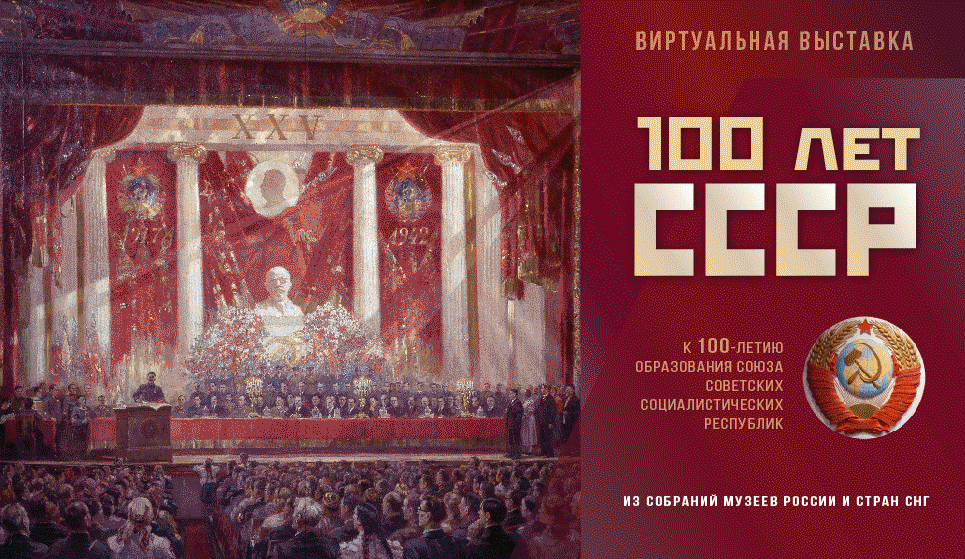
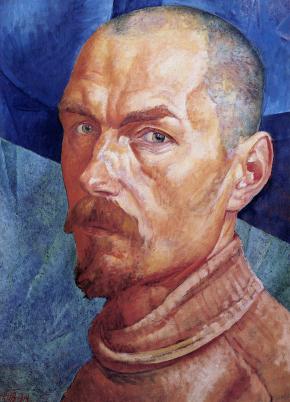
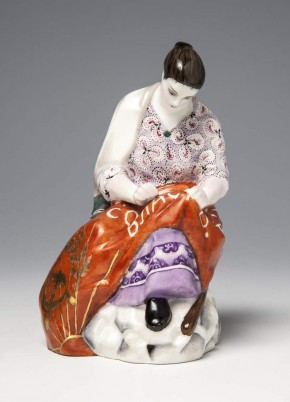
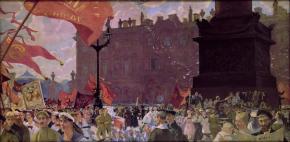
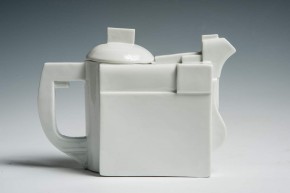
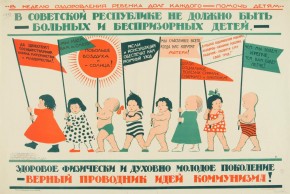
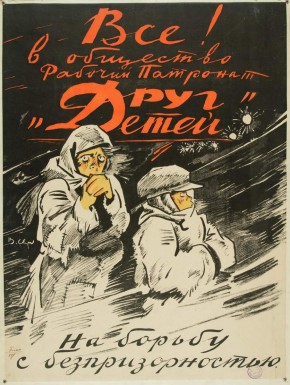

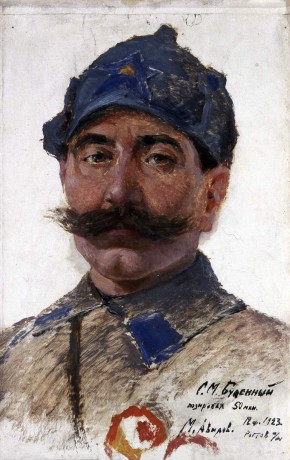
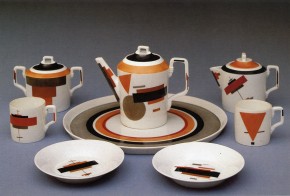
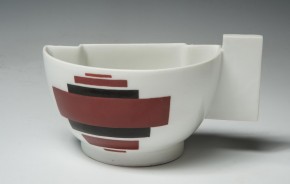
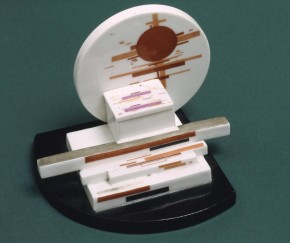
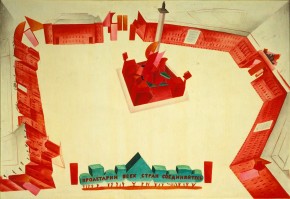
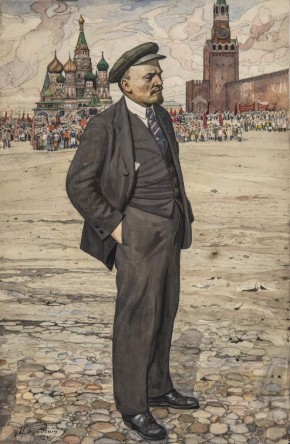
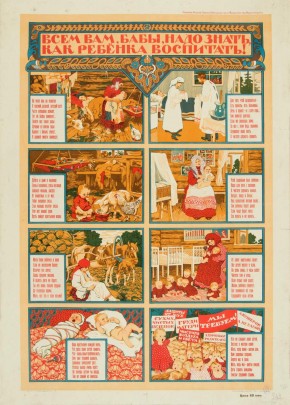

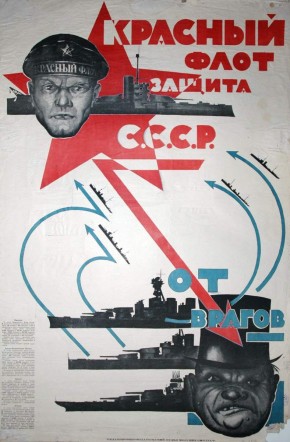
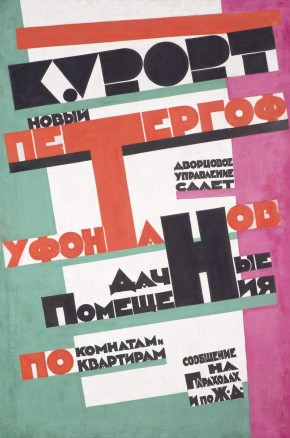

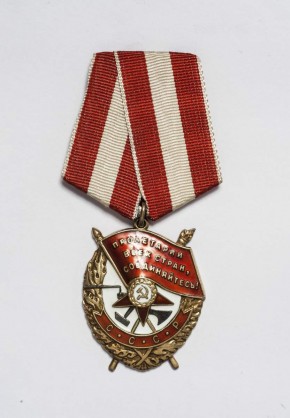
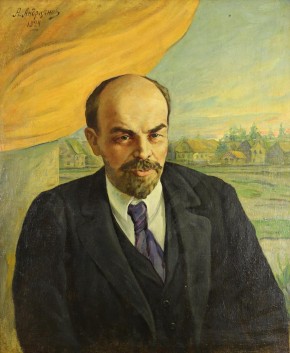
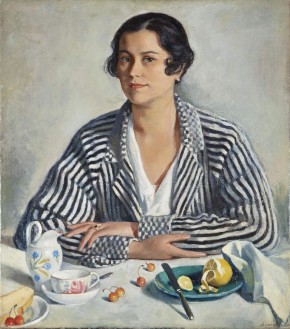
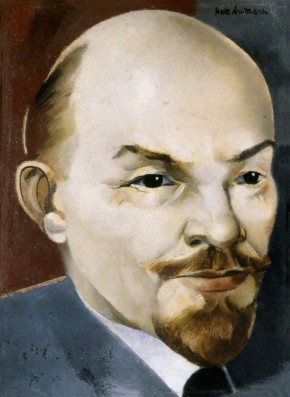
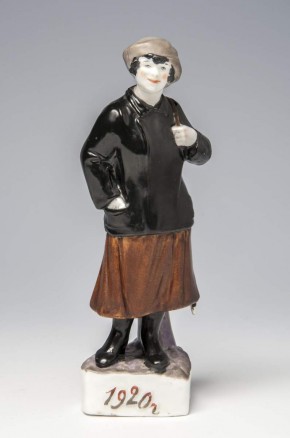
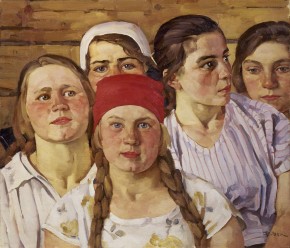
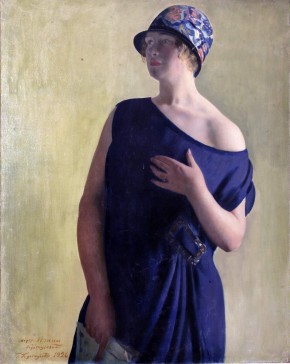
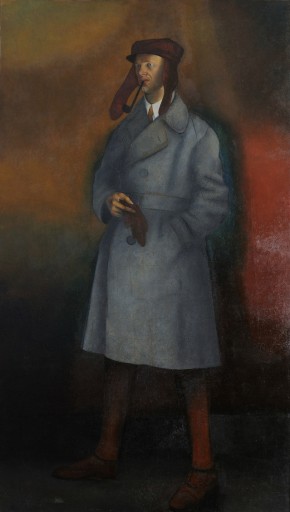

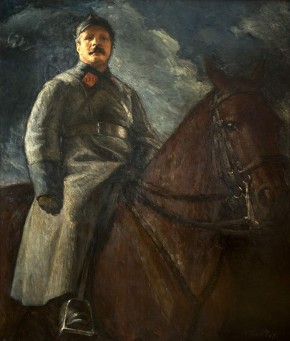
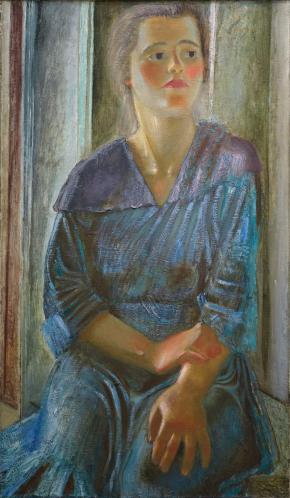
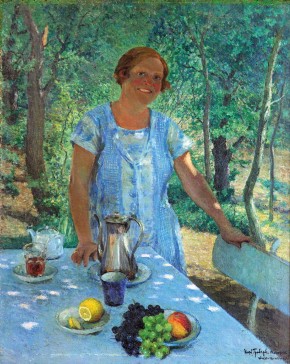

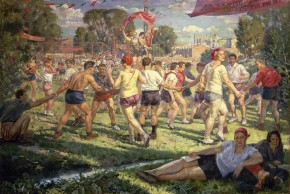
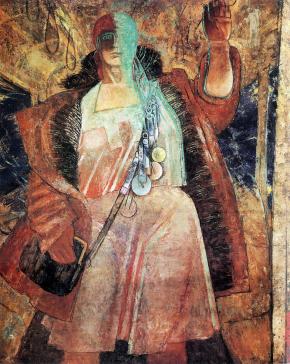
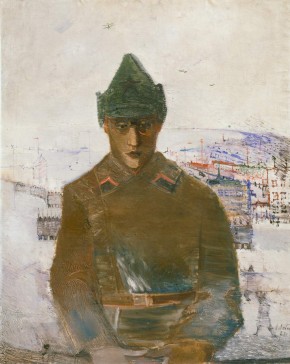

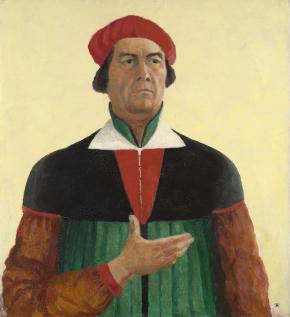
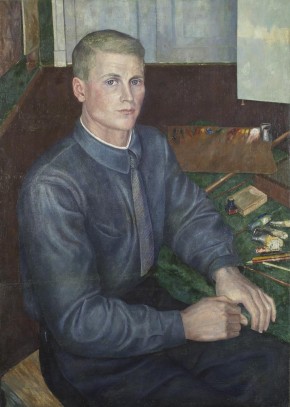
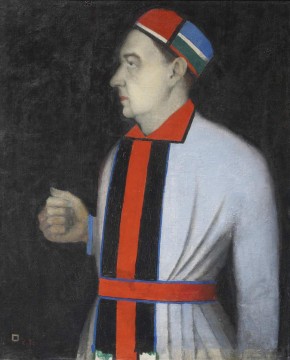
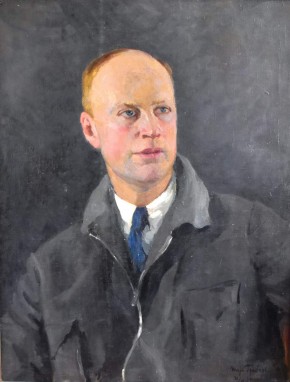

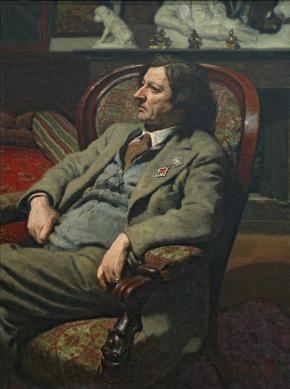
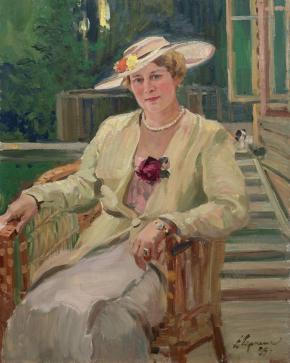
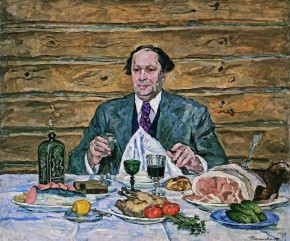
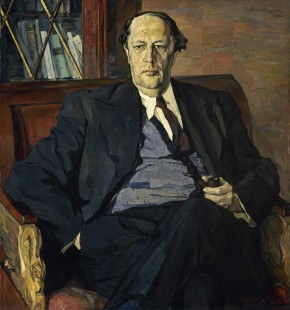
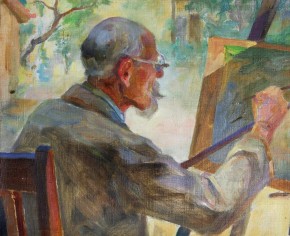
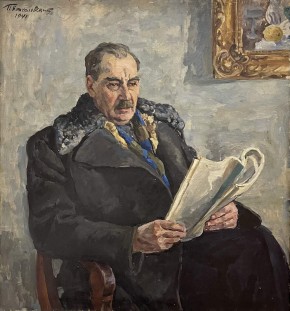
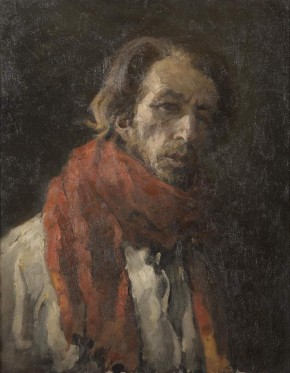
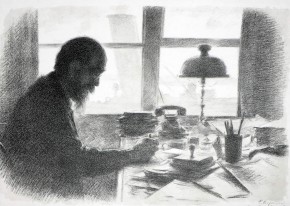
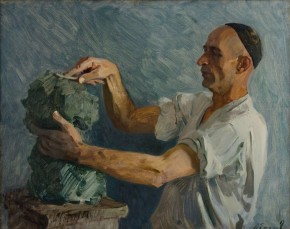
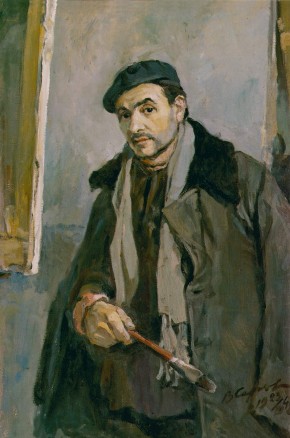
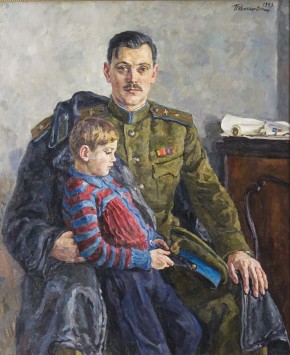
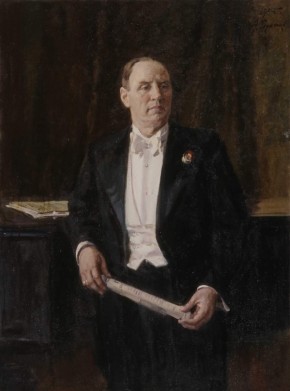
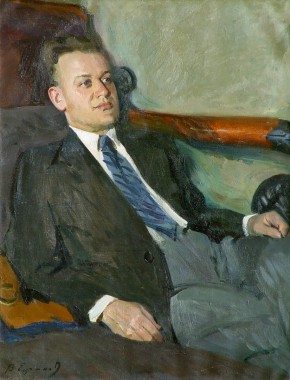
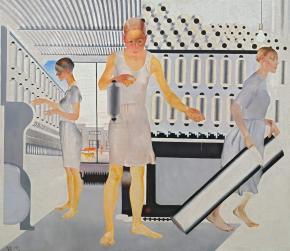

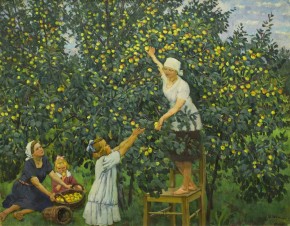
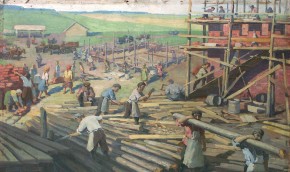


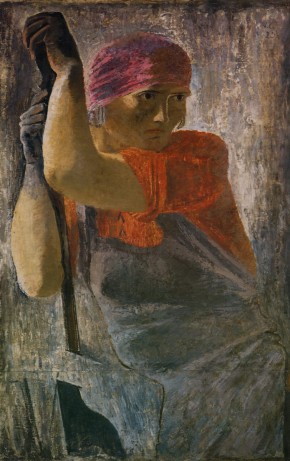
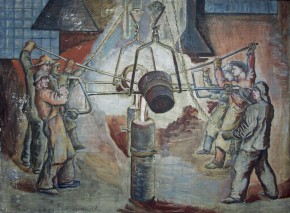
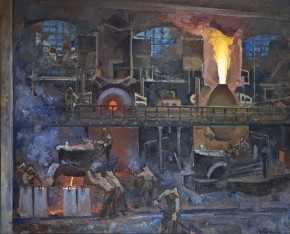
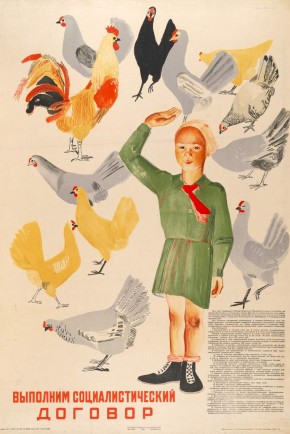
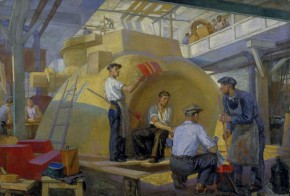
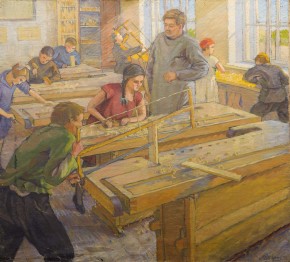
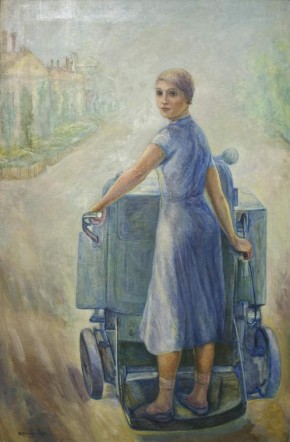
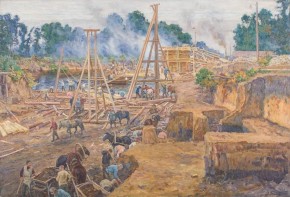

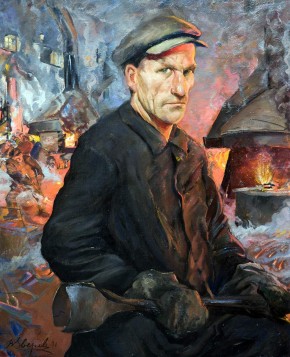
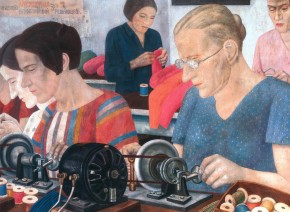
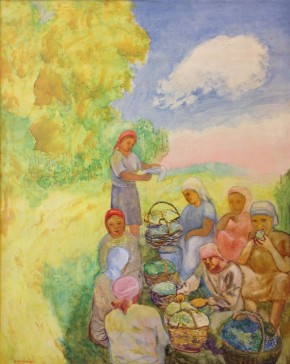
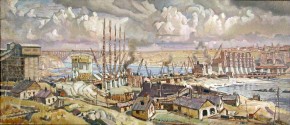
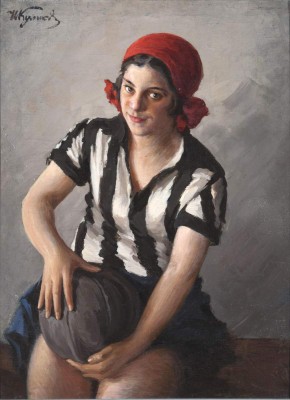
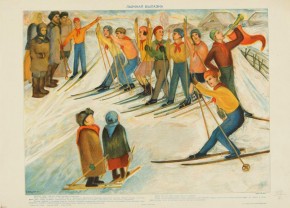

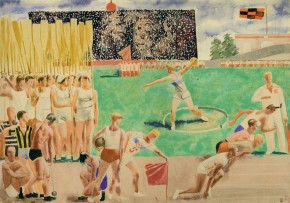
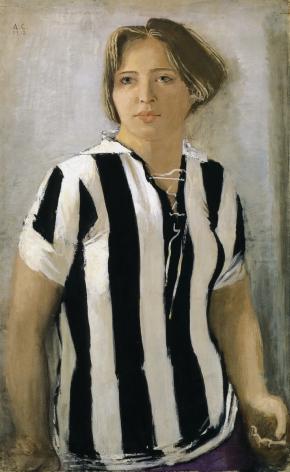

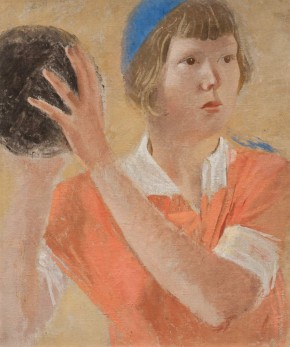
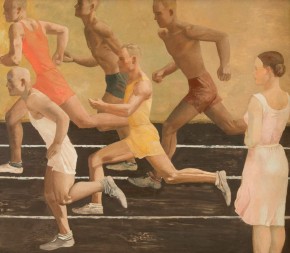
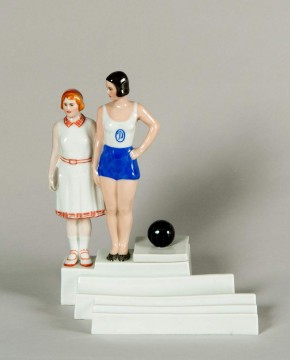
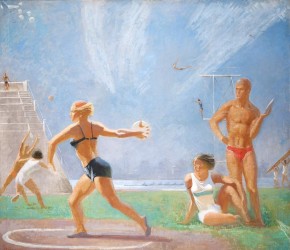
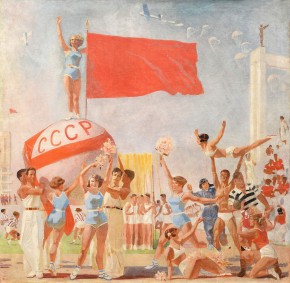

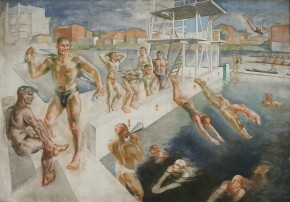
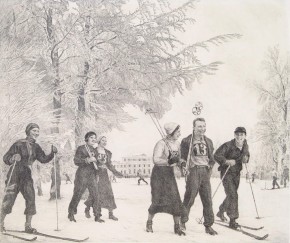
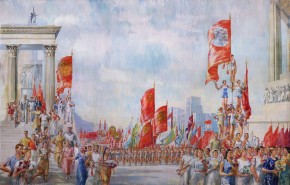

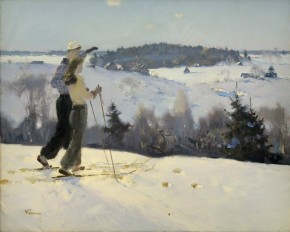
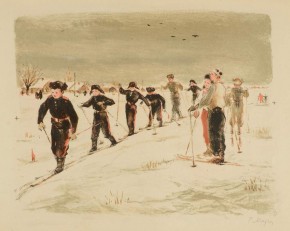
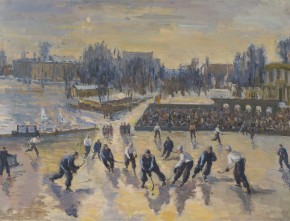
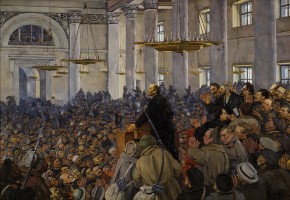
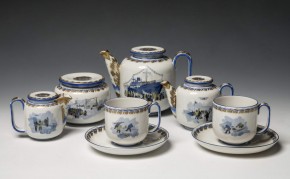
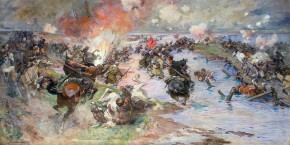

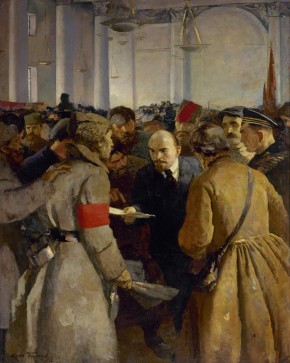
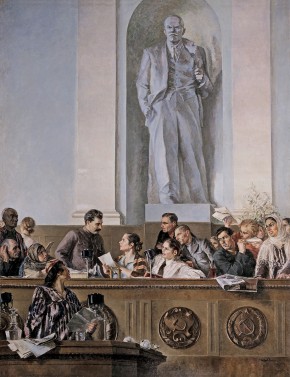
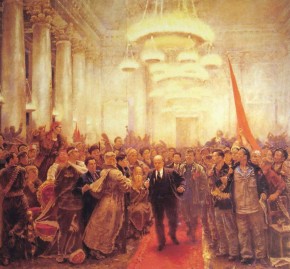
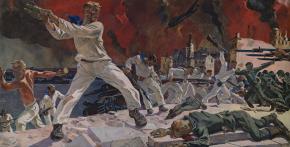
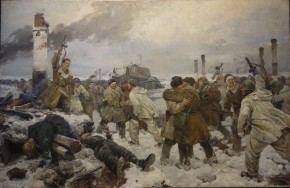
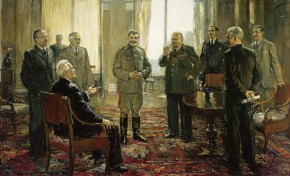
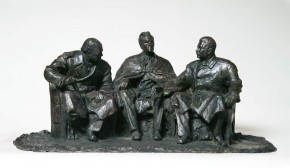
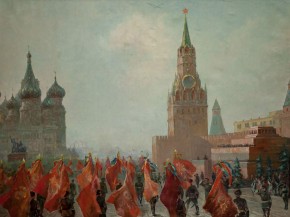
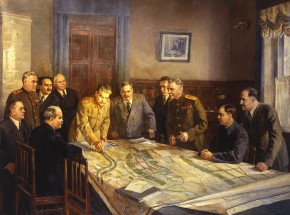
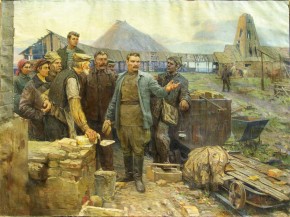
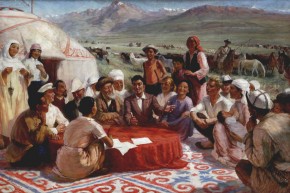

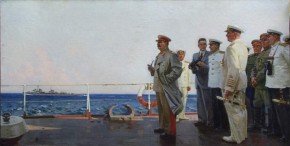
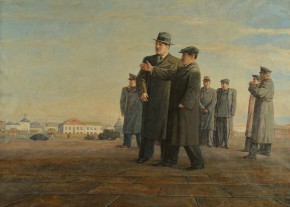
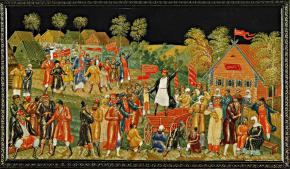
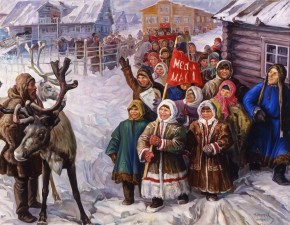
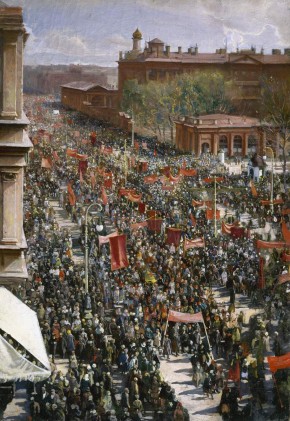
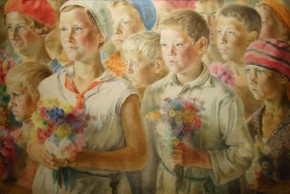
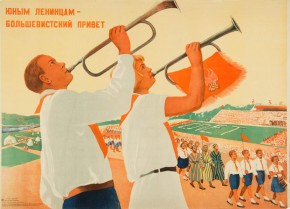

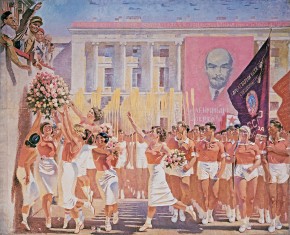
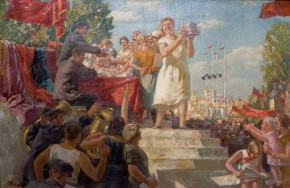
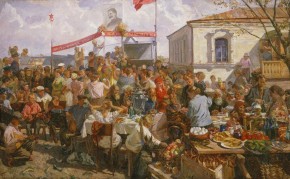

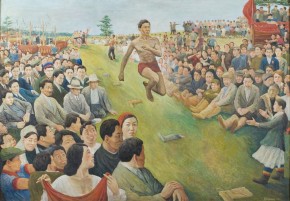
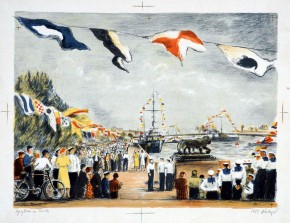
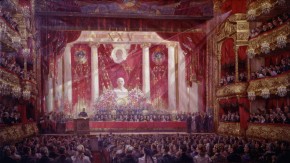
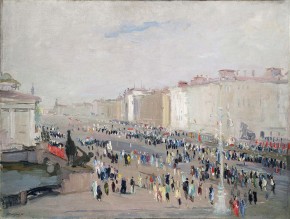
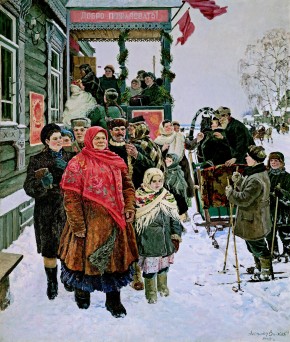
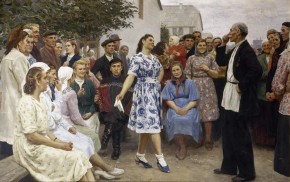
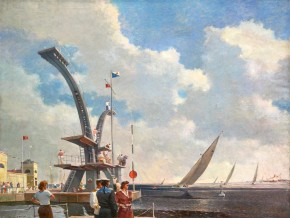
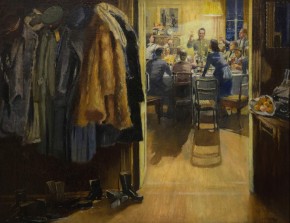
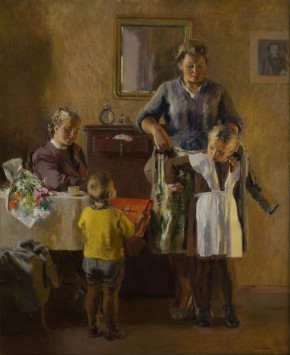
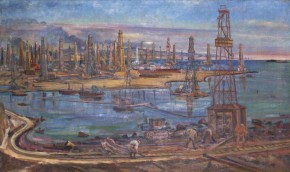
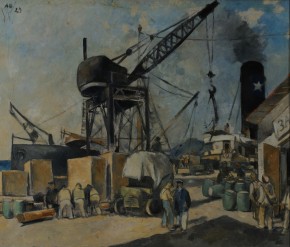
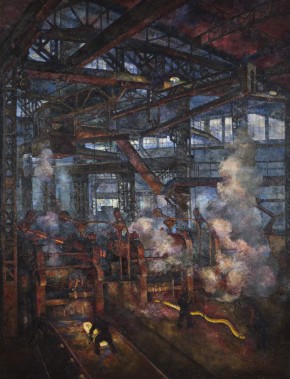

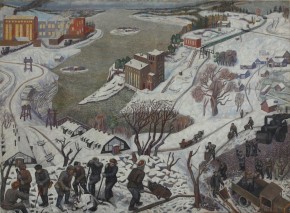
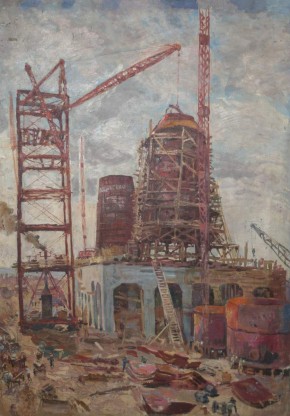
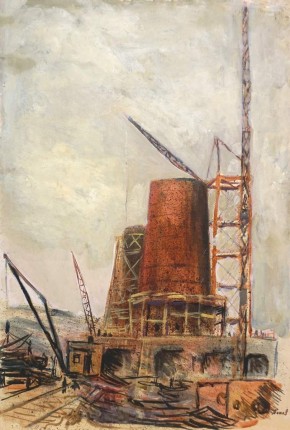
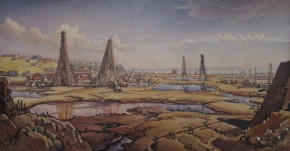
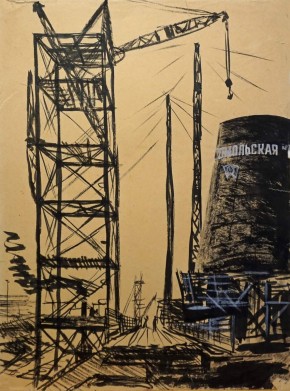
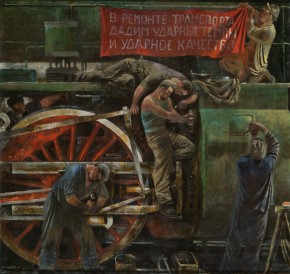
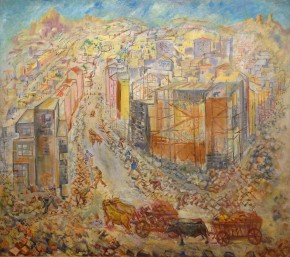
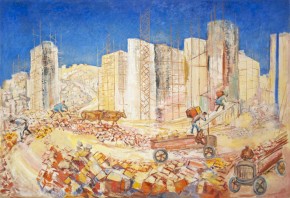
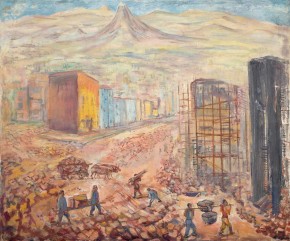
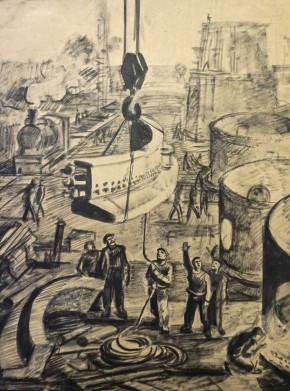

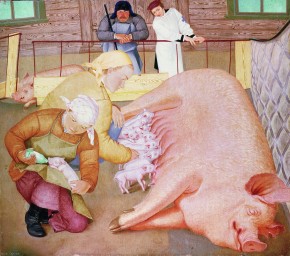
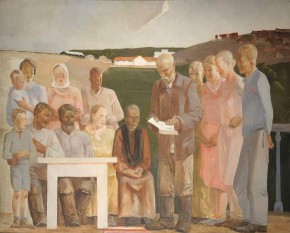
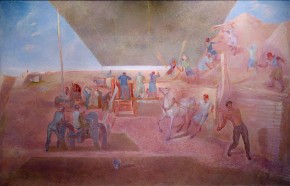
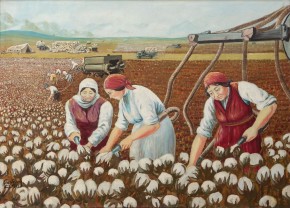
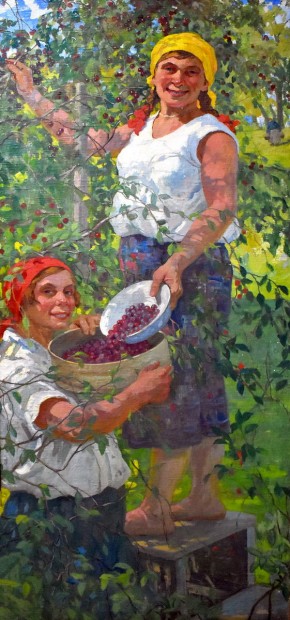
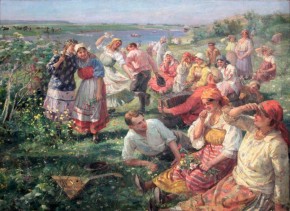
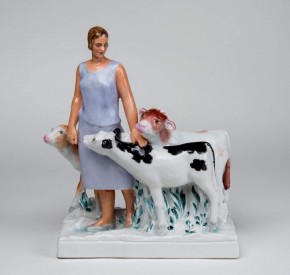
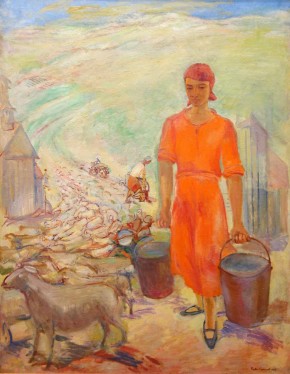
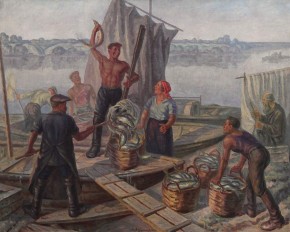
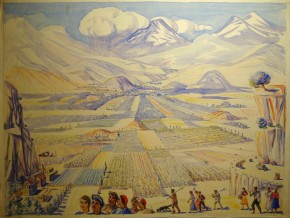
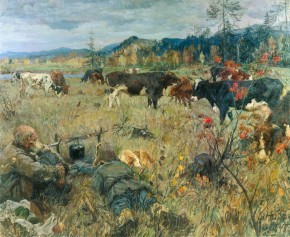
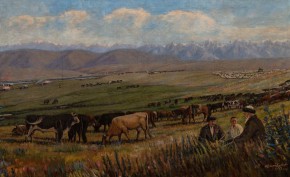
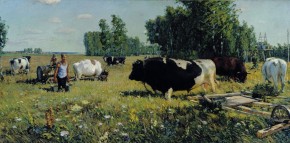
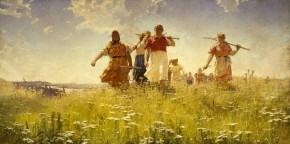
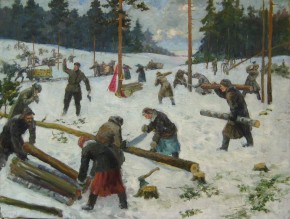
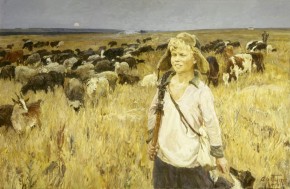

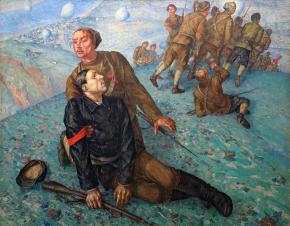
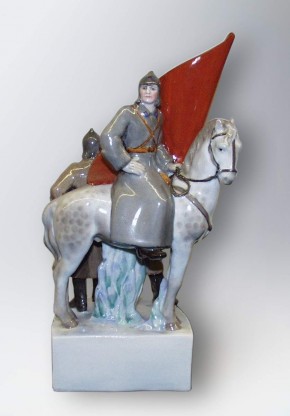

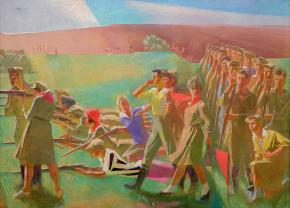
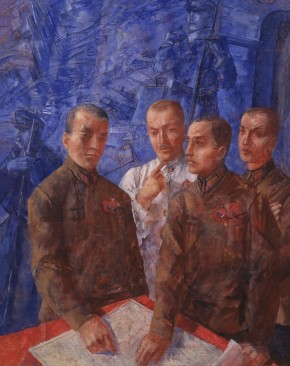

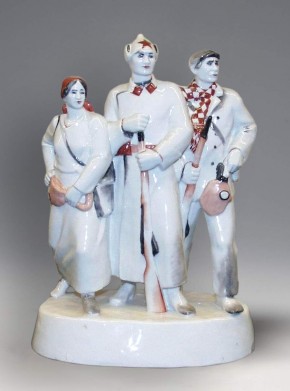
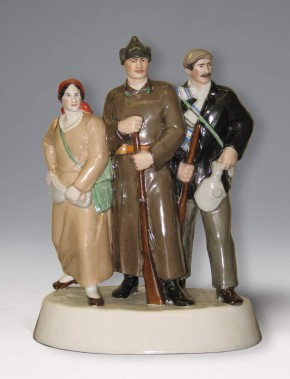
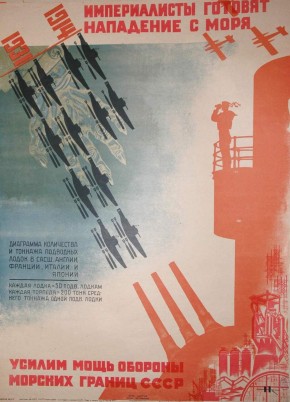
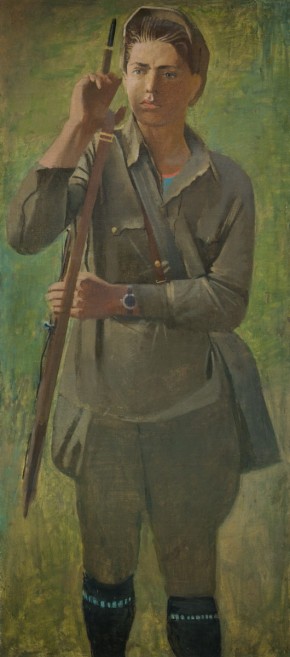
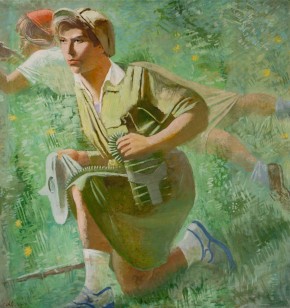
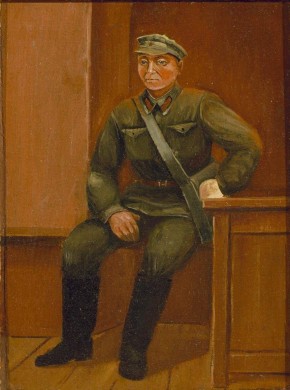
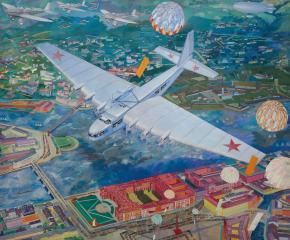
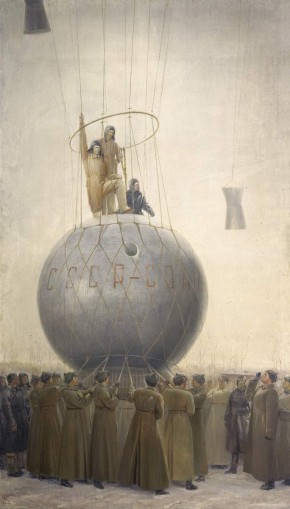
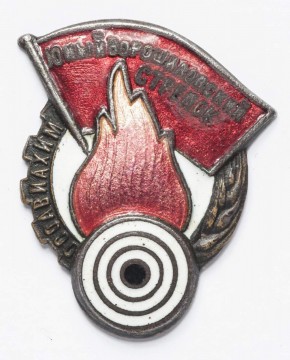
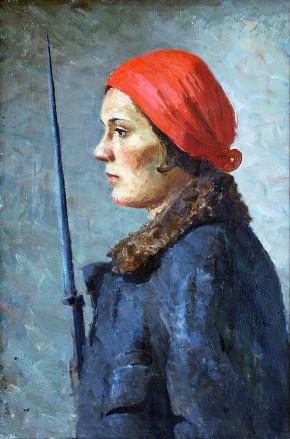

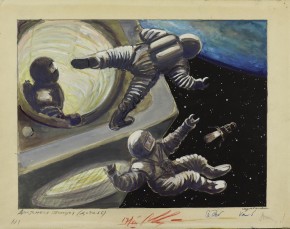
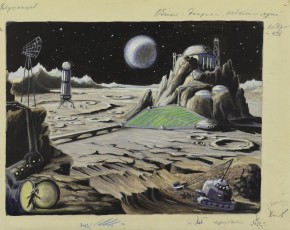

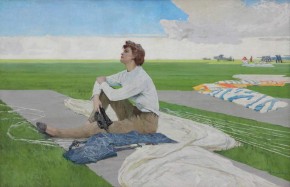
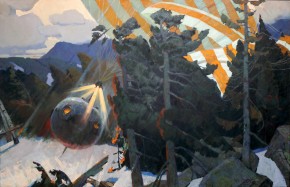
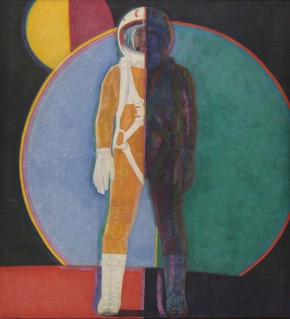
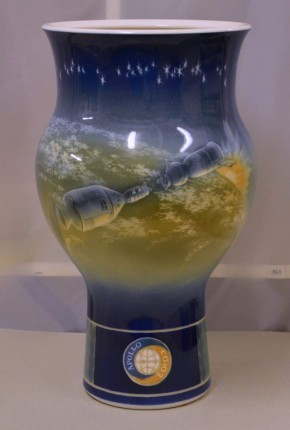
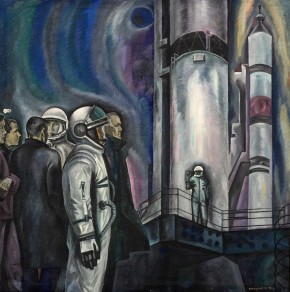
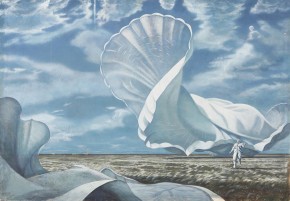
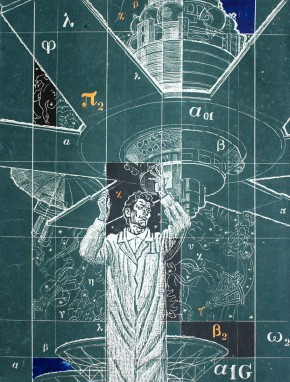
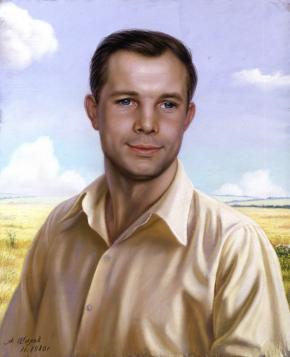


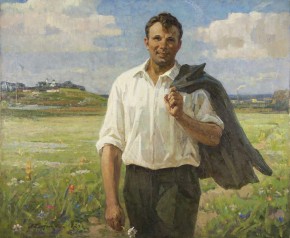
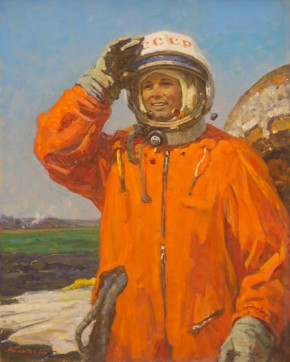
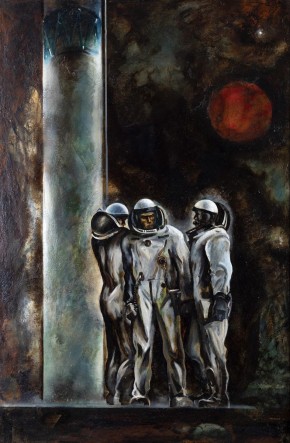

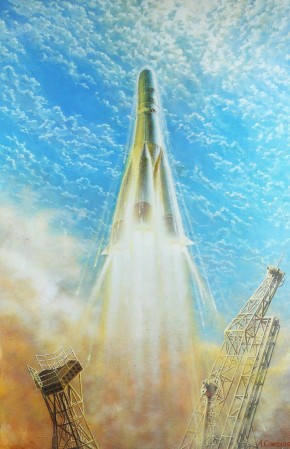
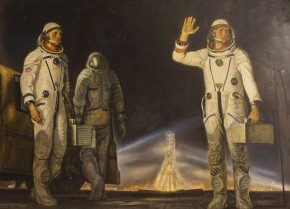
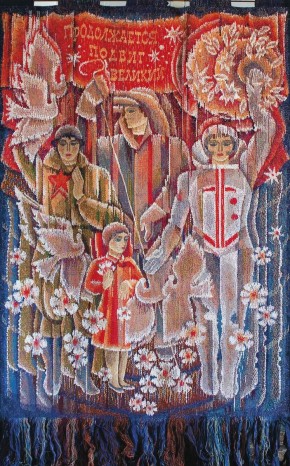
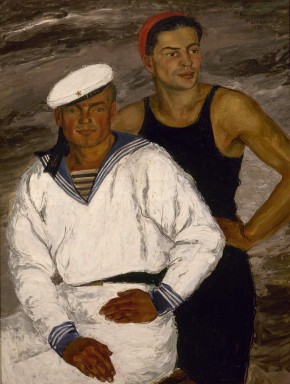
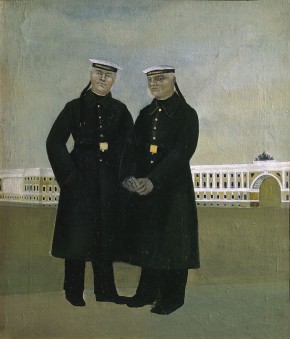
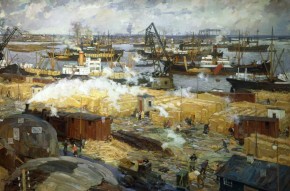
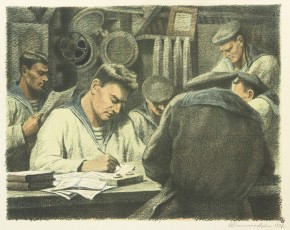
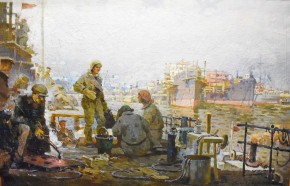
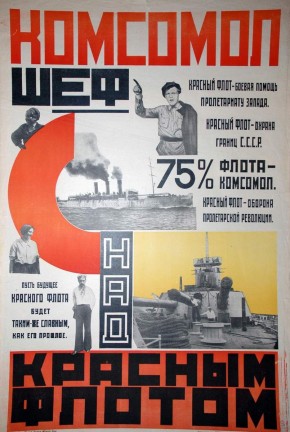
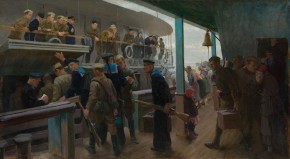
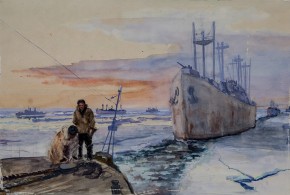
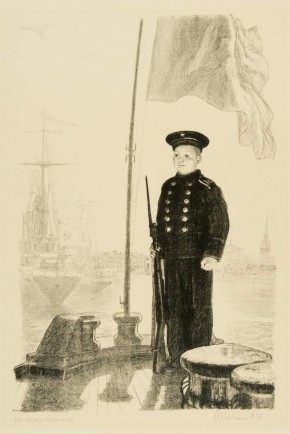
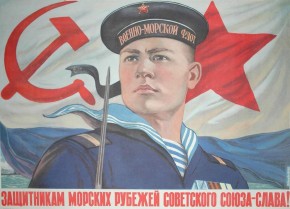
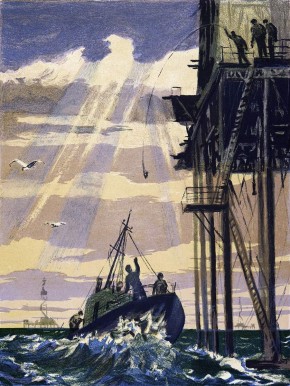
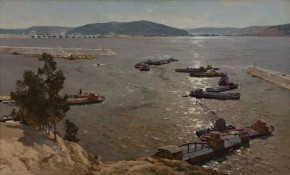
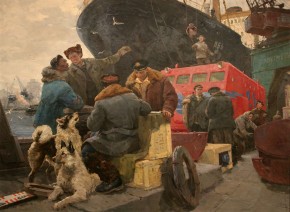
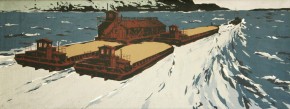
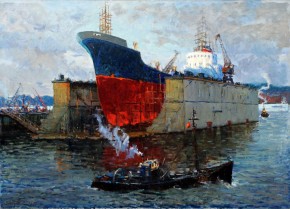
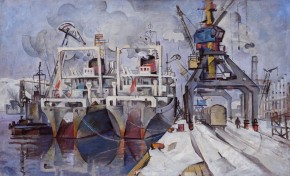
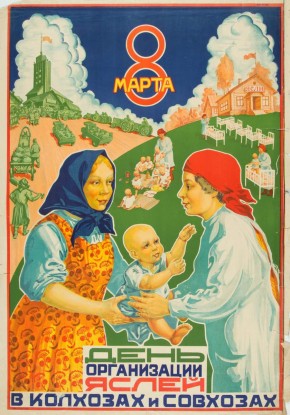
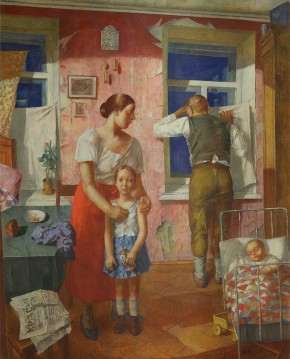
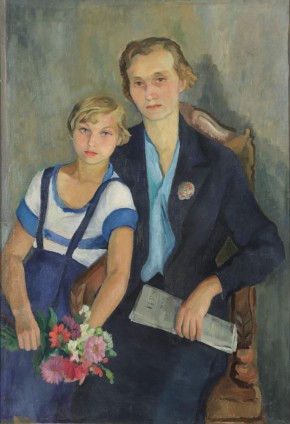
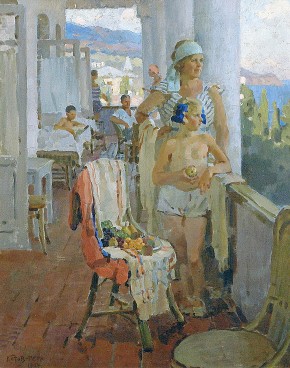
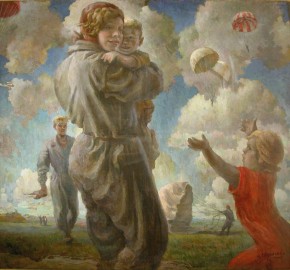
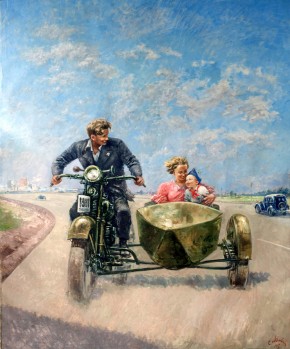
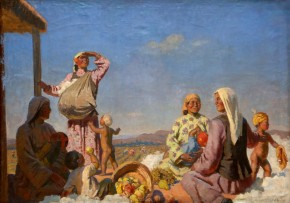
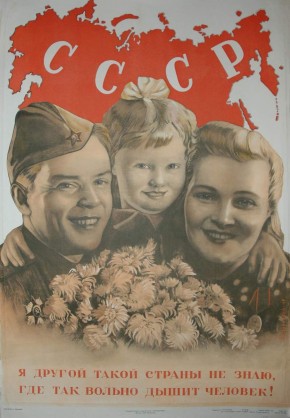
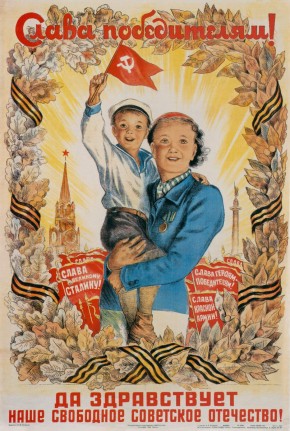
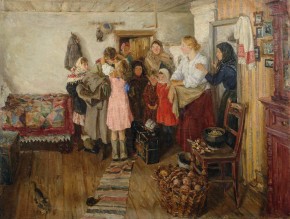
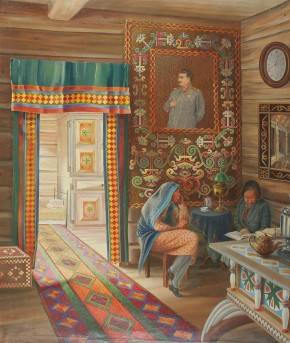
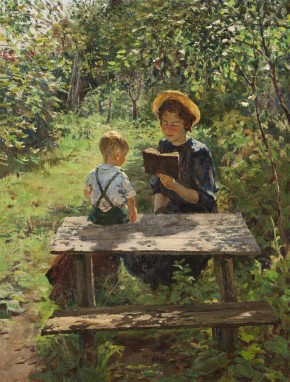
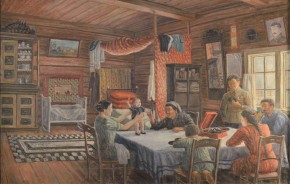
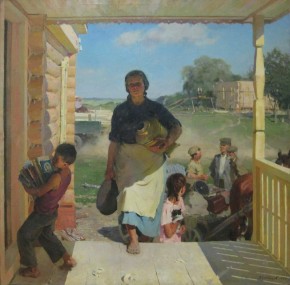
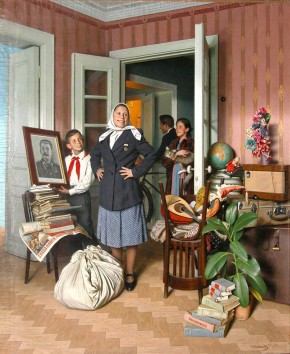
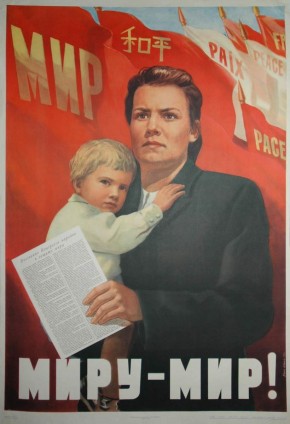
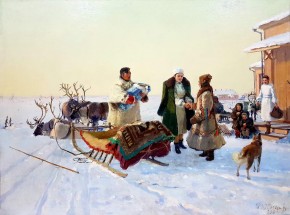
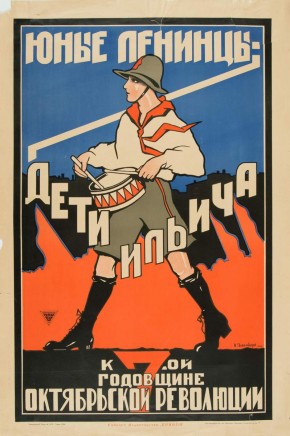
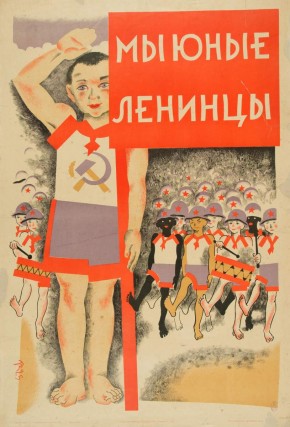
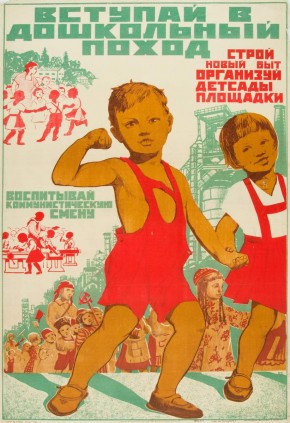

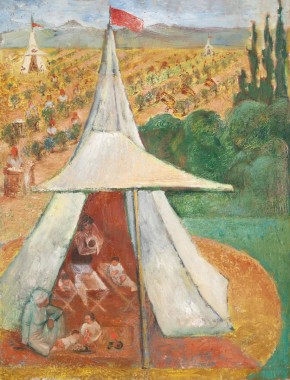
![Хоровод детей всех наций. [Четвертый фрагмент]](/data/collections/painting/19_20/zh-8598/32708_mainfoto_05.jpg)
